People at the Farm and Tiny Lambs
/Every year I offer a Sheep Handling and Management class that occurs sometime during lambing season. This year the timing was lucky! We had twins born in the morning before the class started and a ewe started lambing during class.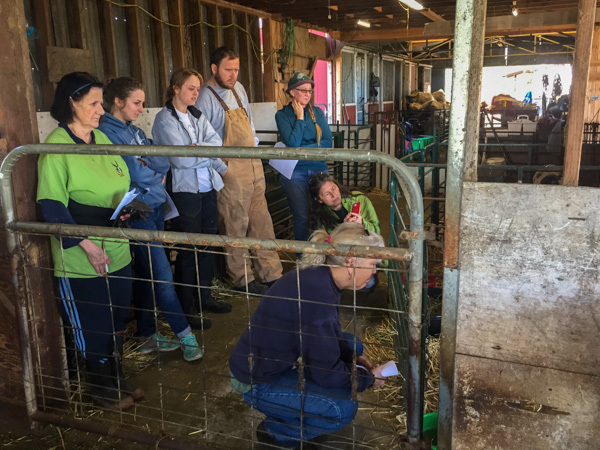 During the discussion about other aspects of raising sheep we kept an eye on Zinnia, the ewe who was lambing. When she got more serious we watched.
During the discussion about other aspects of raising sheep we kept an eye on Zinnia, the ewe who was lambing. When she got more serious we watched.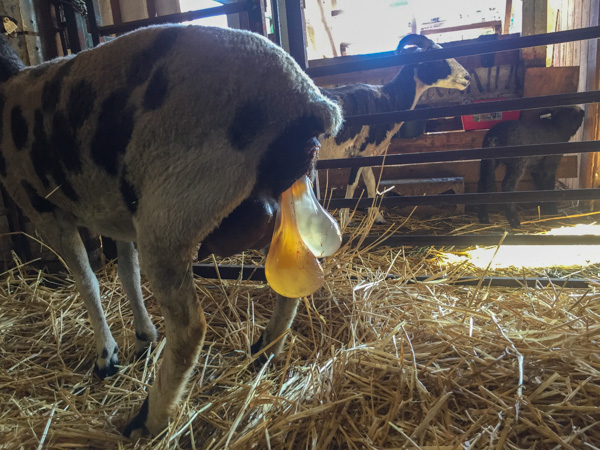 One thing of note was the presence of two bags, each a different color. A lot of time I just see membranes that have broken so I wouldn't know if it were one or two, but it seemed unusual to see two distinct bags. I saw a bit of a small foot emerging but the whole thing seemed to be taking awhile so I thought I'd check. There was one foot and a head. Not very far back was another head. Both lambs were coming at the same time, and it was obvious from the two sacs that one had meconium staining, a sign of fetal distress. I pushed the second lamb back and was able to pull the first lamb with just the head and one foot. I could tell that it was very small. Usually it takes a little while for the second to come, but it was right there too. Weighing these later, they were 4.8 and 4.2 pounds.
One thing of note was the presence of two bags, each a different color. A lot of time I just see membranes that have broken so I wouldn't know if it were one or two, but it seemed unusual to see two distinct bags. I saw a bit of a small foot emerging but the whole thing seemed to be taking awhile so I thought I'd check. There was one foot and a head. Not very far back was another head. Both lambs were coming at the same time, and it was obvious from the two sacs that one had meconium staining, a sign of fetal distress. I pushed the second lamb back and was able to pull the first lamb with just the head and one foot. I could tell that it was very small. Usually it takes a little while for the second to come, but it was right there too. Weighing these later, they were 4.8 and 4.2 pounds.

Both lambs were alive. The second lamb acted unusual. Most lambs start trying to get up within minutes of birth but there is a normal sequence that I have a hard time describing. It's just something that I've seen many times. (If you go to my YouTube channel and look at lambing videos you'll see this.) The second lamb was noisy, baaing constantly and sort of scrabbling with it's feet. It seemed frantic as opposed to a more methodical attempt to stand.
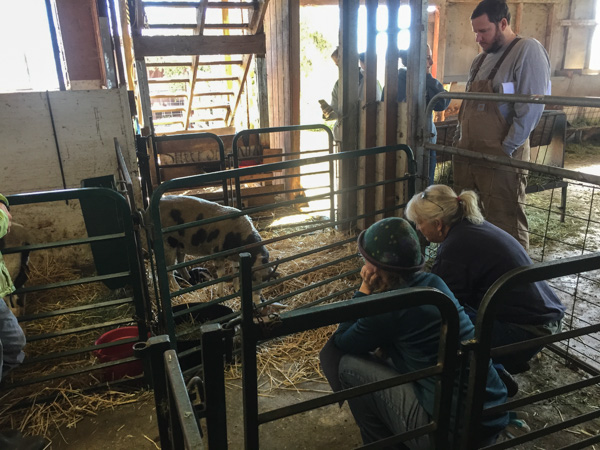 You can't rush a lamb to be ready to nurse. I didn't know if something was wrong with this one, but I knew that, even if it was normal, it needed a little more time. We went outside and looked at the fences and the pasture. When we came back in the first lamb was doing fine. The second still wasn't able to stand but I could hold it up and get it to nurse.
You can't rush a lamb to be ready to nurse. I didn't know if something was wrong with this one, but I knew that, even if it was normal, it needed a little more time. We went outside and looked at the fences and the pasture. When we came back in the first lamb was doing fine. The second still wasn't able to stand but I could hold it up and get it to nurse.
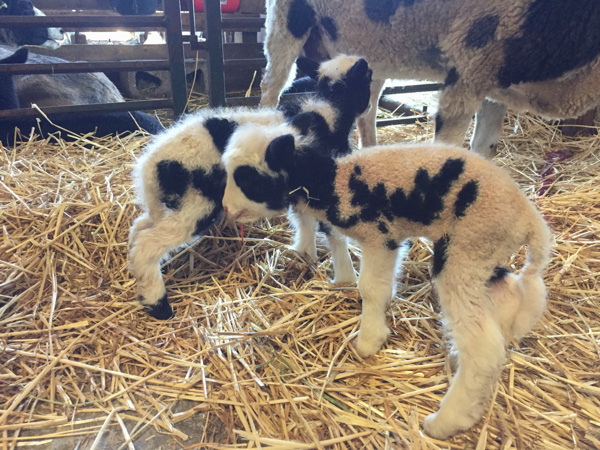 We kept checking back and eventually the second lamb was on it's feet. This photo was taken later in the day.
We kept checking back and eventually the second lamb was on it's feet. This photo was taken later in the day.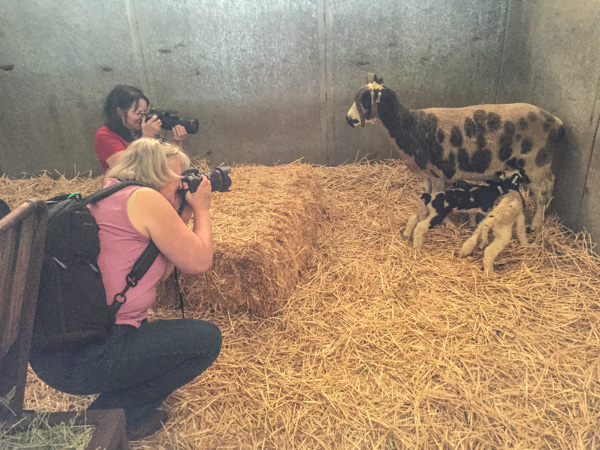 Later that afternoon a friend of mine came with another friend to take photos of the lambs. That's Raquel with triplet ram lambs.
Later that afternoon a friend of mine came with another friend to take photos of the lambs. That's Raquel with triplet ram lambs.
The three of us spent time in the pasture photographing lambs before we came in to go out to dinner.
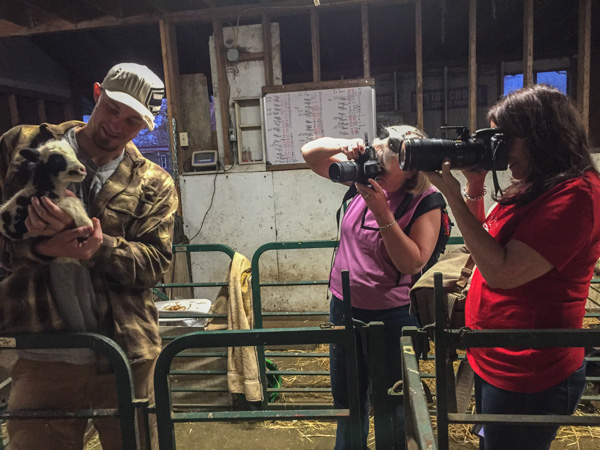 Here is the tiny lamb from the morning.
Here is the tiny lamb from the morning.
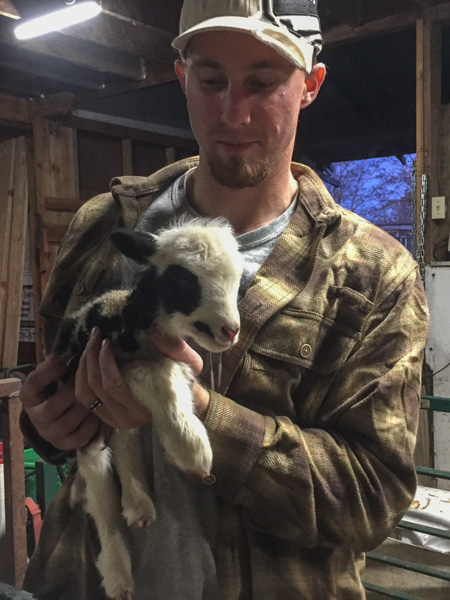
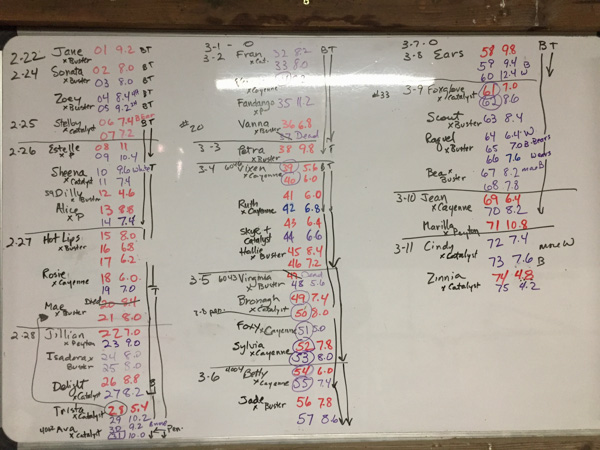 This was getting close to the end of lambing.
This was getting close to the end of lambing.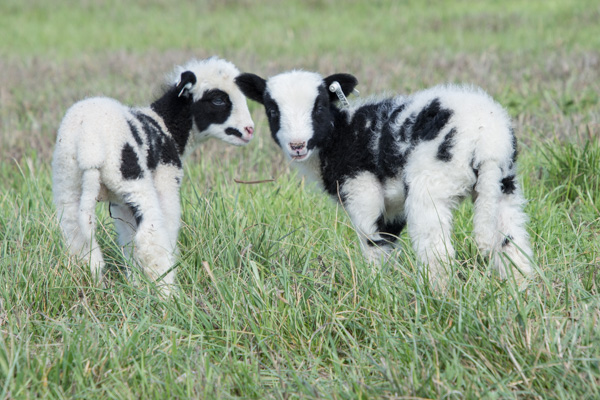 Here are those two tiny lambs 12 days later and here is their listing on the website.
Here are those two tiny lambs 12 days later and here is their listing on the website.
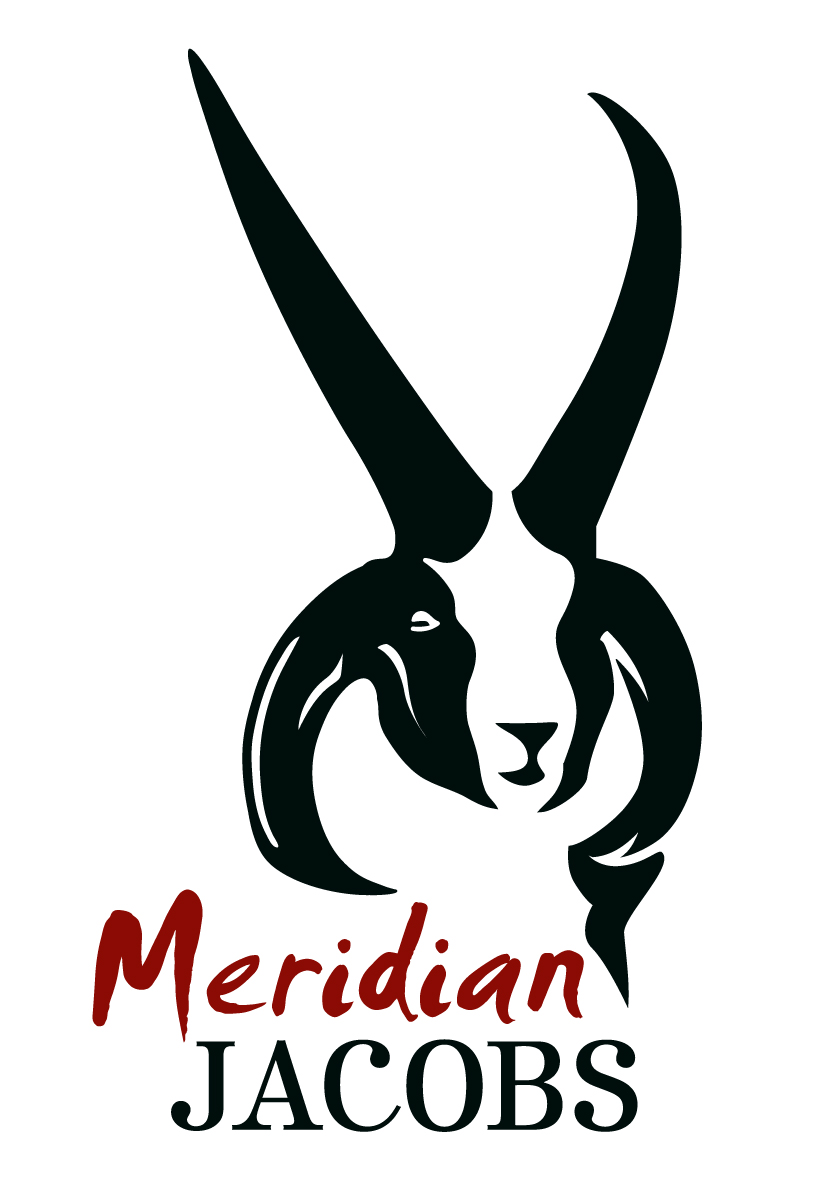
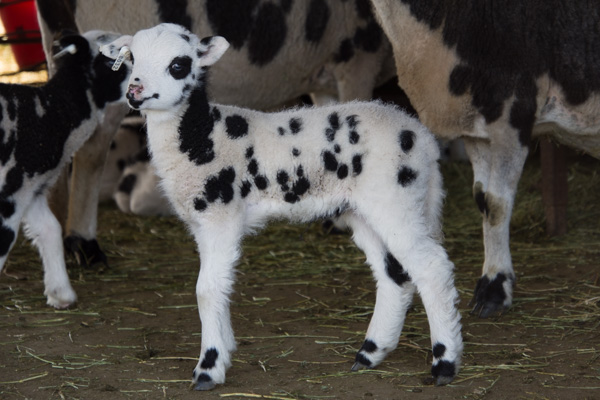
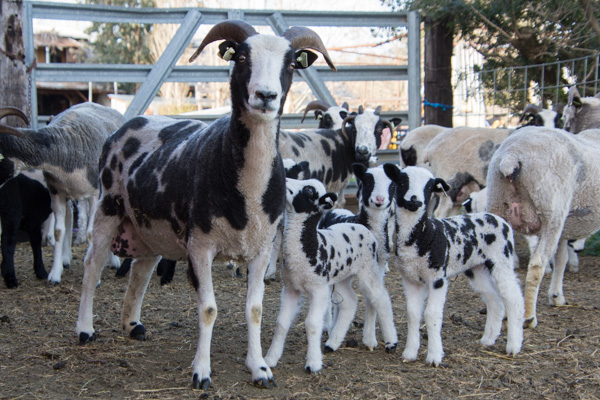
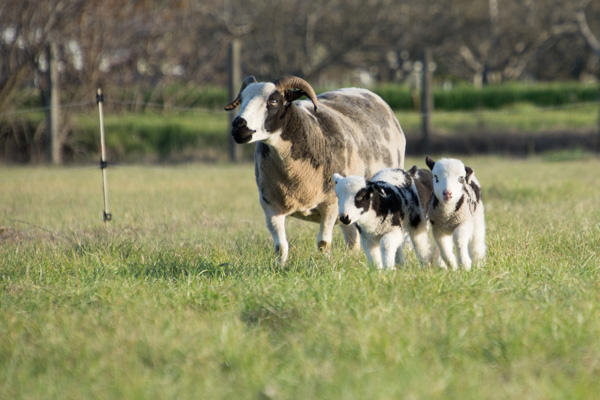
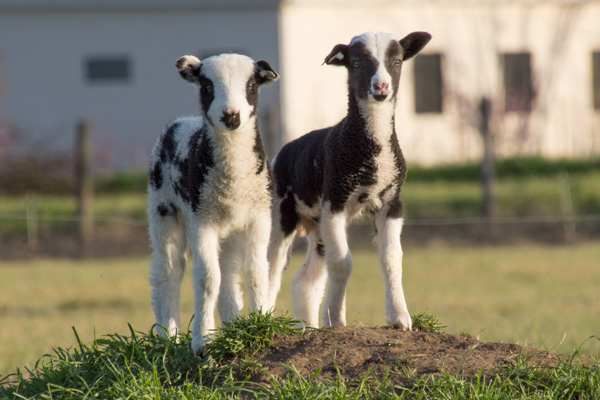
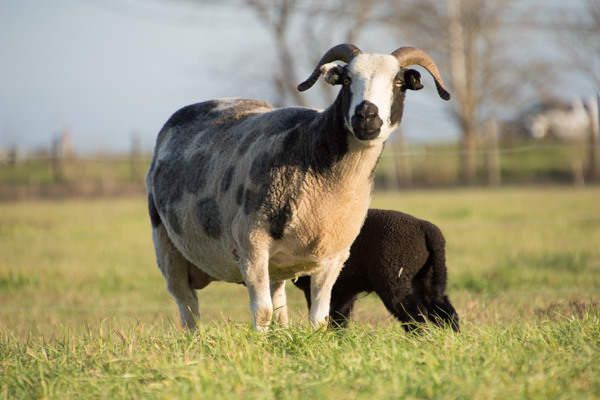
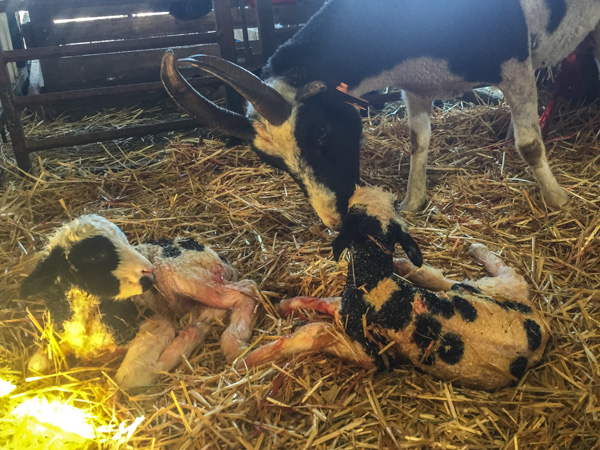 Jade is the biggest pet sheep here.
Jade is the biggest pet sheep here. 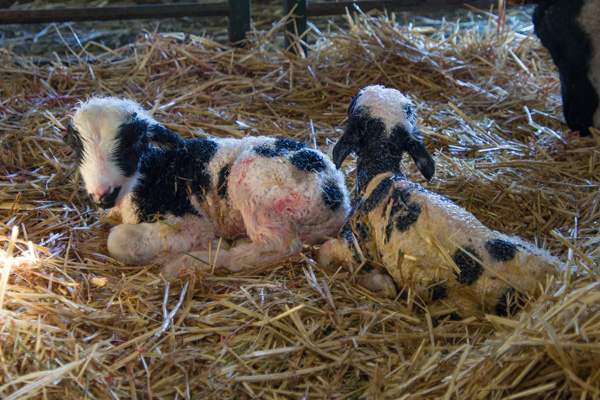 She had a ewe and a ram lamb.
She had a ewe and a ram lamb.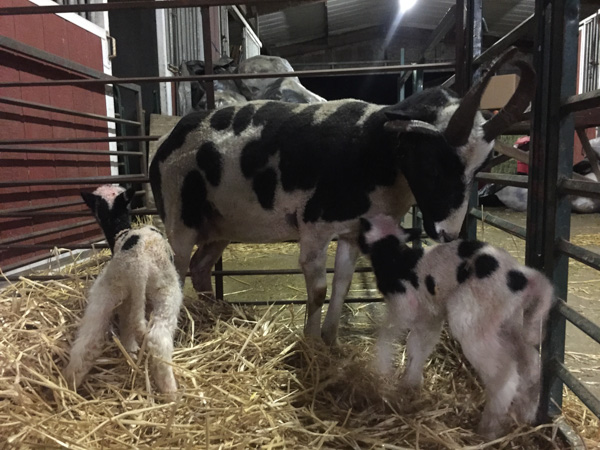 At that point I had overflow pens set up in the alley of the barn.
At that point I had overflow pens set up in the alley of the barn.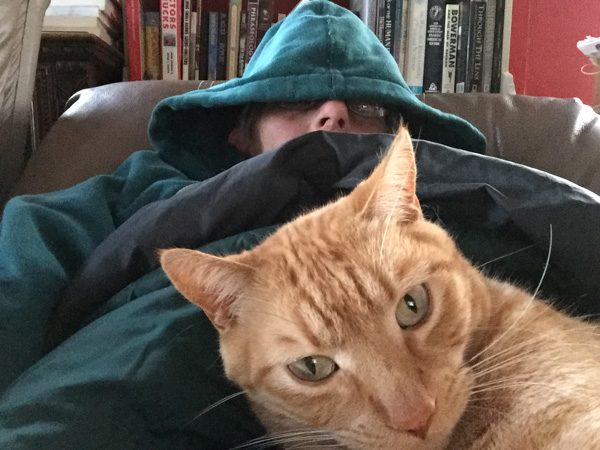 I think I slept some here and then was woken up.
I think I slept some here and then was woken up.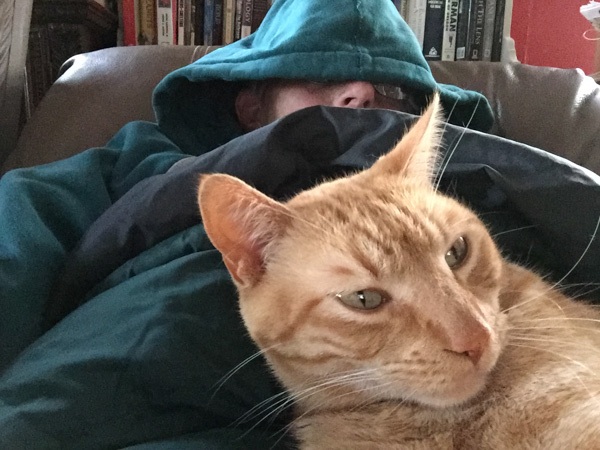
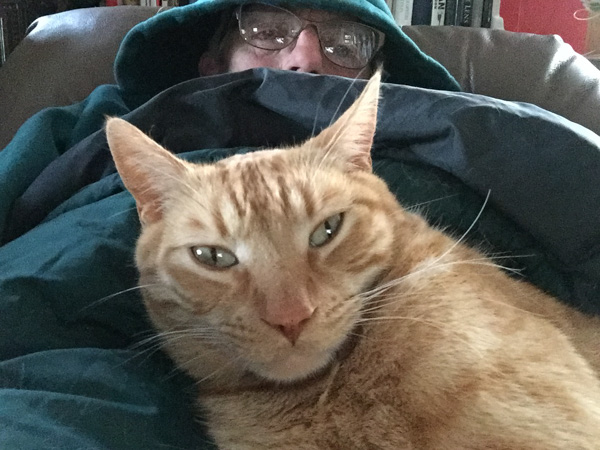 It looks as though Sunny is getting sleepy here. But I'm awake.
It looks as though Sunny is getting sleepy here. But I'm awake.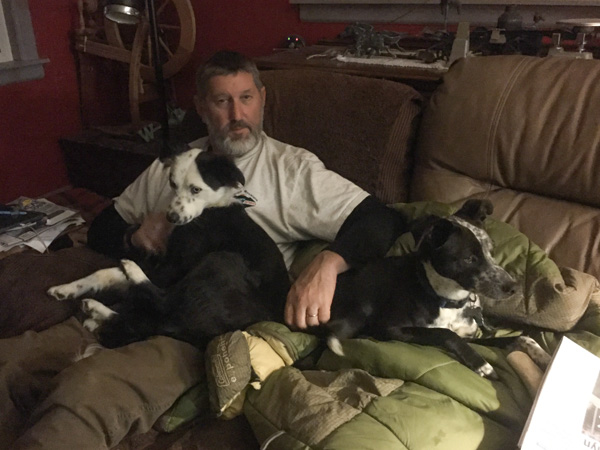 My son works as an EMT and he is often gone at night. The "puppies", who live next door, get invited in our house if they are barking too much. They have no qualms about cuddling on the couch, something our dogs don't get to do.
My son works as an EMT and he is often gone at night. The "puppies", who live next door, get invited in our house if they are barking too much. They have no qualms about cuddling on the couch, something our dogs don't get to do.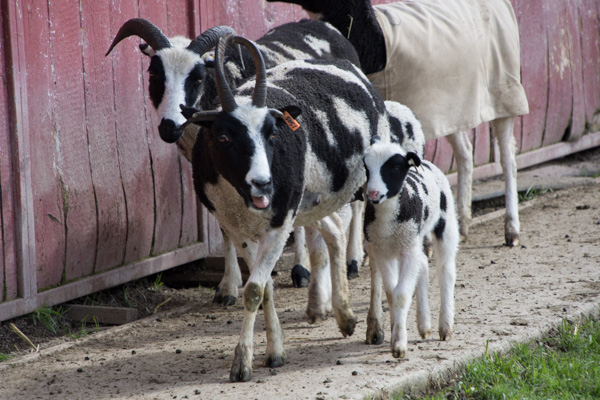 Back to Jade. Here she is with one of her lambs at 2-1/2 weeks old.
Back to Jade. Here she is with one of her lambs at 2-1/2 weeks old.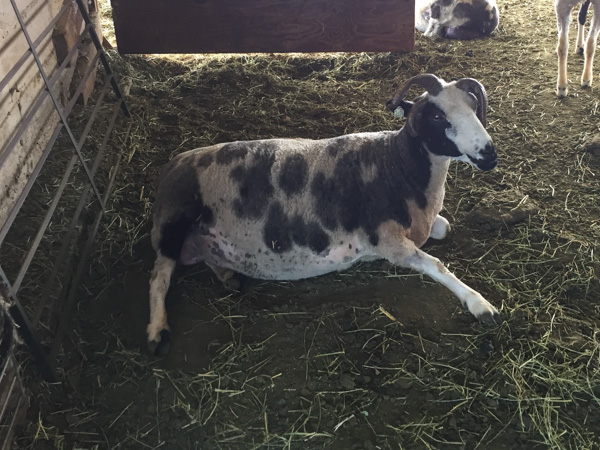 Here she is the previous day, looking rather uncomfortable.
Here she is the previous day, looking rather uncomfortable.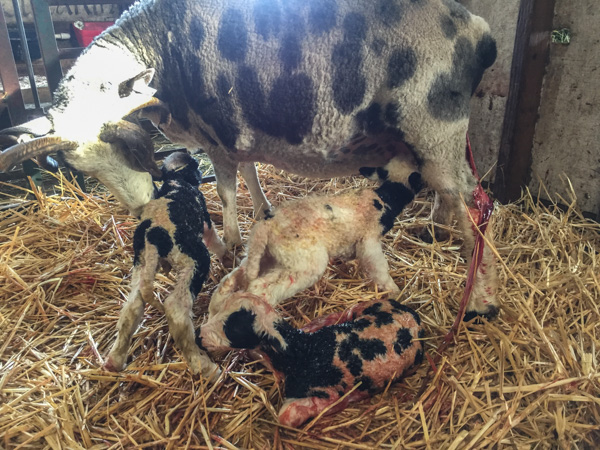
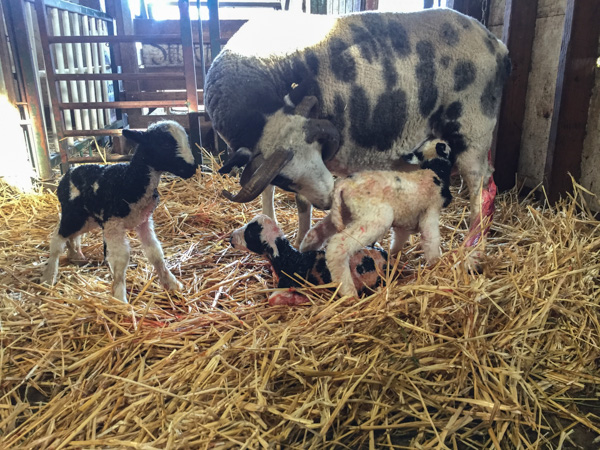
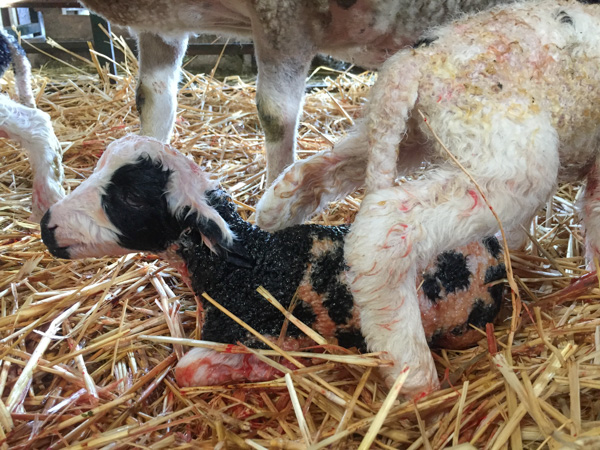
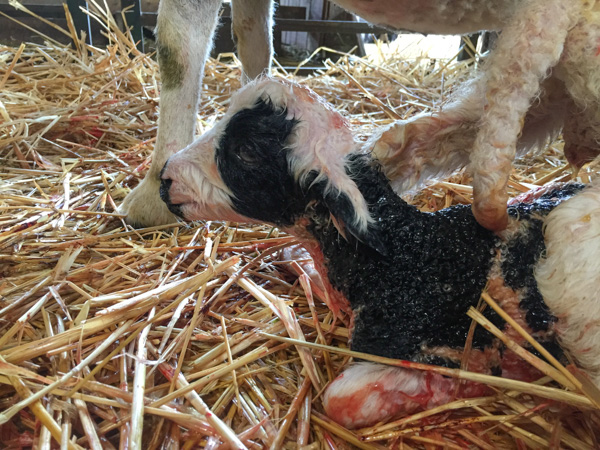
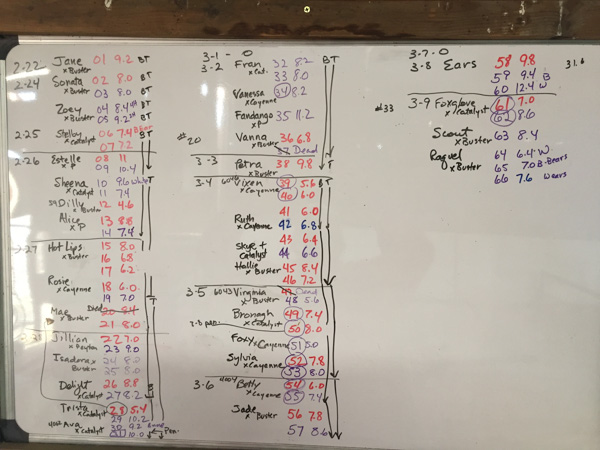 Here is how the barn list looked at the end of the day.
Here is how the barn list looked at the end of the day.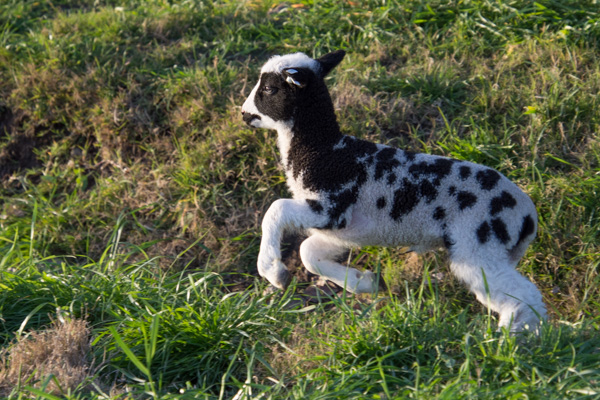 Meanwhile , in the pasture the lambs were playing.
Meanwhile , in the pasture the lambs were playing.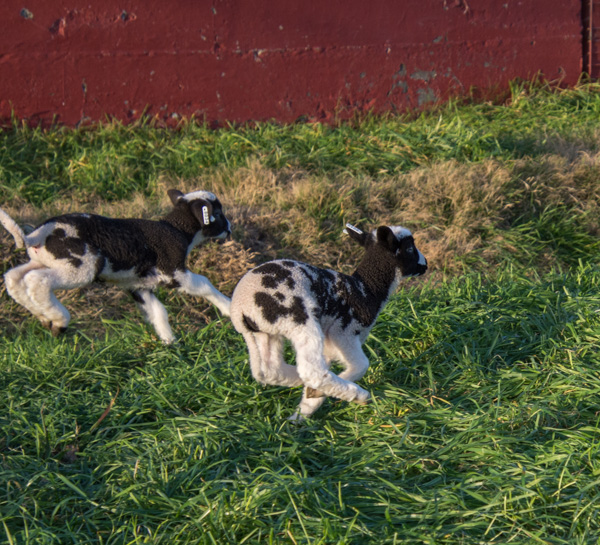
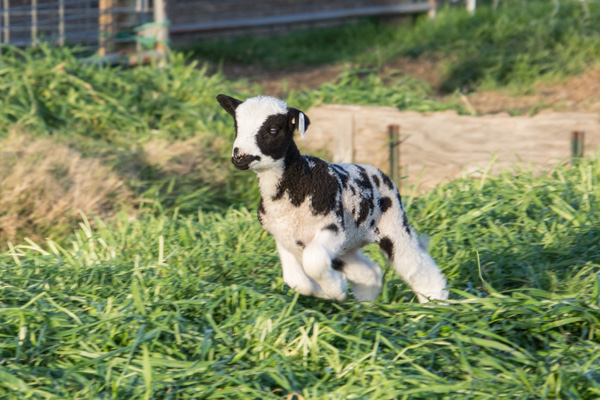
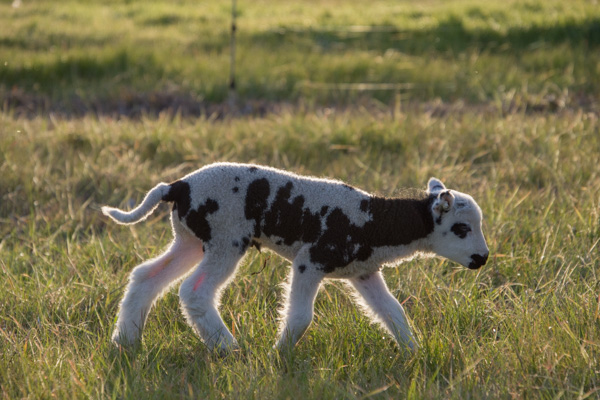
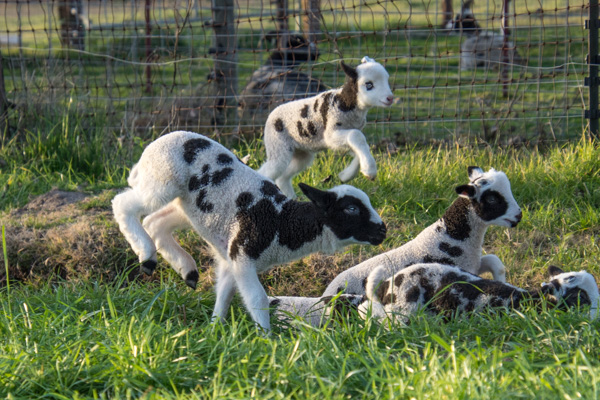
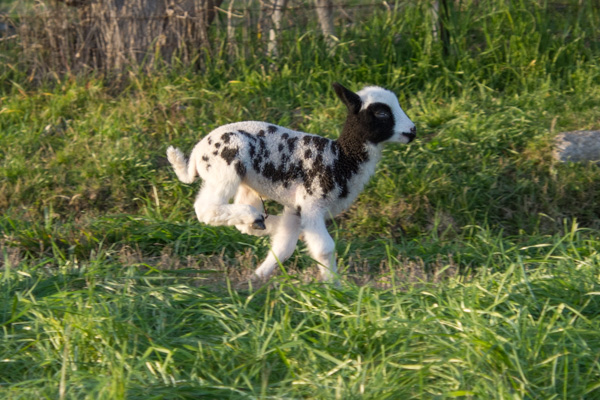
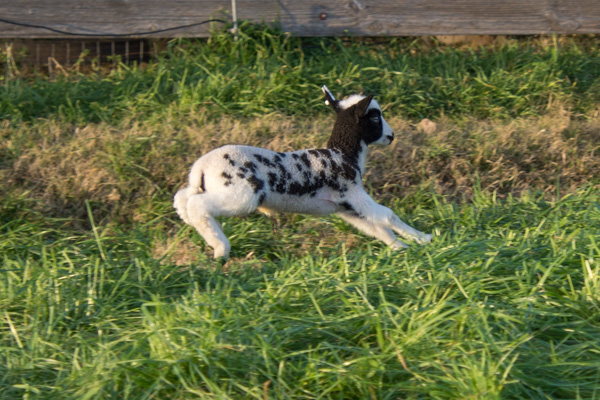
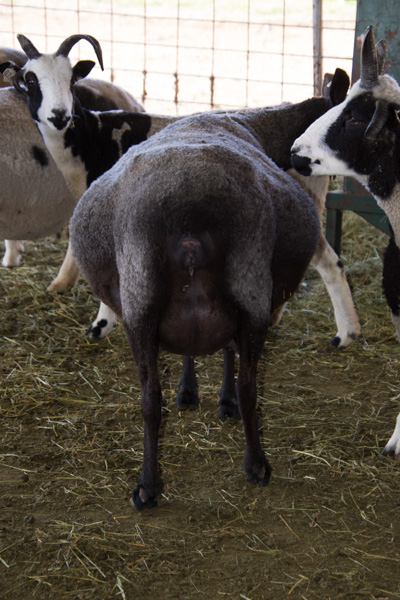 This photo was taken two days prior to the day she lambed.
This photo was taken two days prior to the day she lambed.
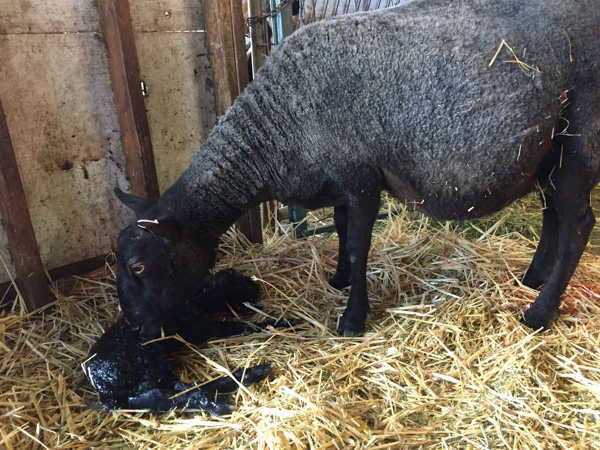 I now have a different BFL ram here so Ears was bred to Peyton, making her lambs 75% BFL.
I now have a different BFL ram here so Ears was bred to Peyton, making her lambs 75% BFL.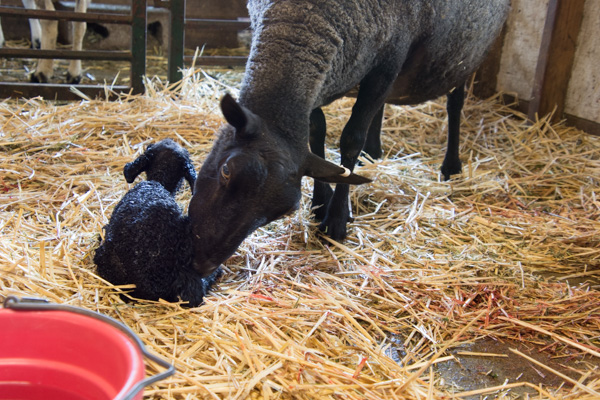 The first lamb was born about 1 in the afternoon.
The first lamb was born about 1 in the afternoon.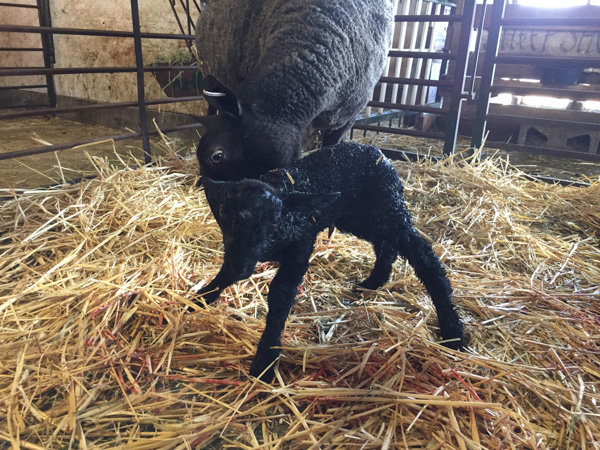 He was on his feet within 15 minutes.
He was on his feet within 15 minutes.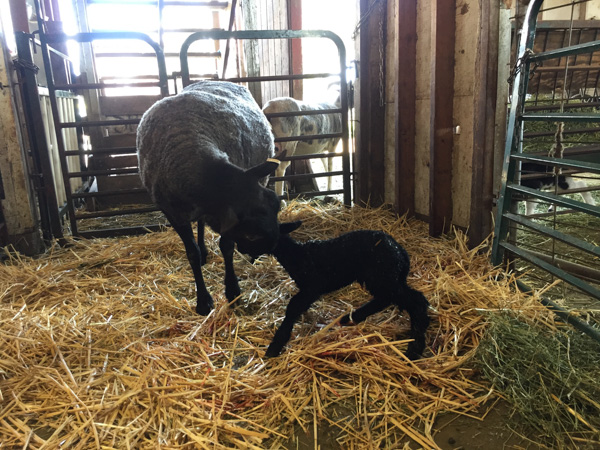 Even after as many lambs as I've watched just after birth I am always amazed by how quickly they stand and try to nurse.
Even after as many lambs as I've watched just after birth I am always amazed by how quickly they stand and try to nurse.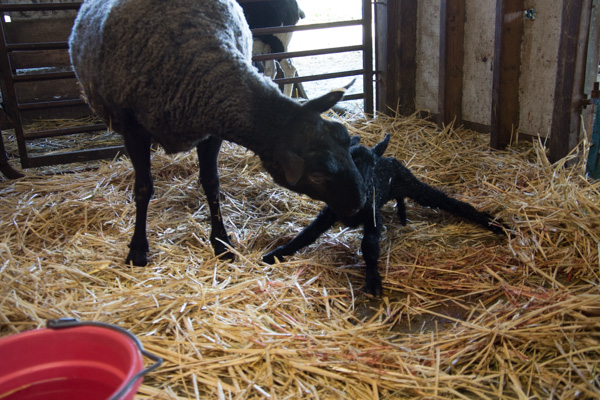
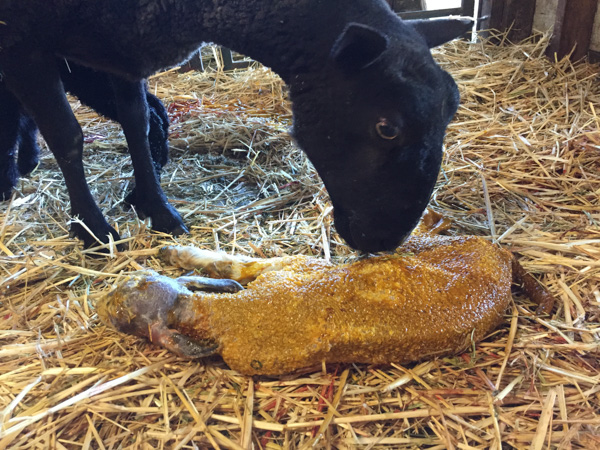 Ears was working on the next lamb but it was an hour after the first had been born and I saw significant meconium staining. That indicates some level of fetal distress, so I pulled this lamb. No wonder it was slow in coming--it was 12.4 pounds!
Ears was working on the next lamb but it was an hour after the first had been born and I saw significant meconium staining. That indicates some level of fetal distress, so I pulled this lamb. No wonder it was slow in coming--it was 12.4 pounds!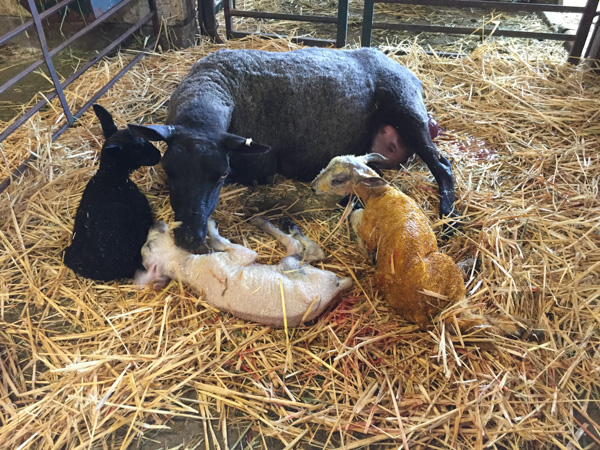 I checked for another lamb and this one was born in about another five minutes.
I checked for another lamb and this one was born in about another five minutes. 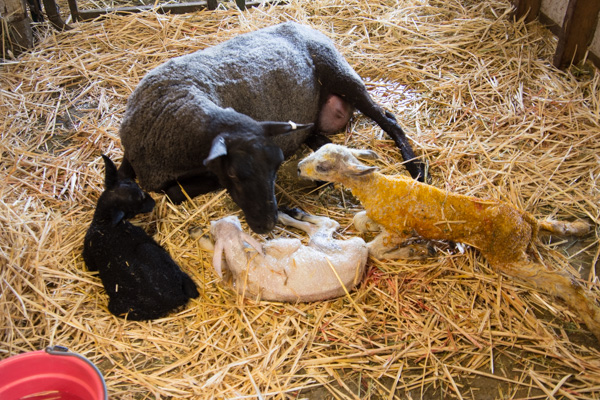 This is 31 pounds of lambs!
This is 31 pounds of lambs!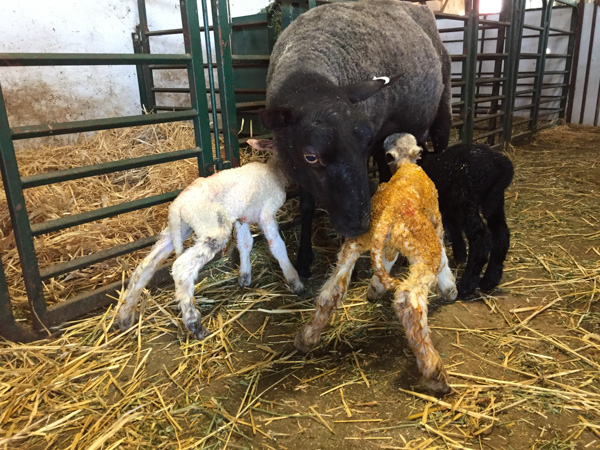 All were up and trying to nurse in half an hour.
All were up and trying to nurse in half an hour. 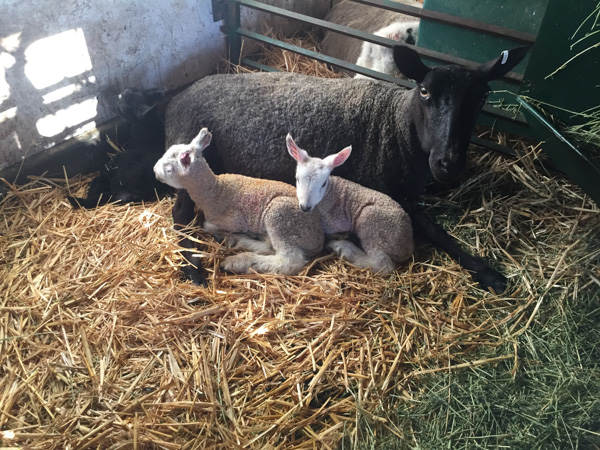 This is Ears and her triplets the next day.
This is Ears and her triplets the next day.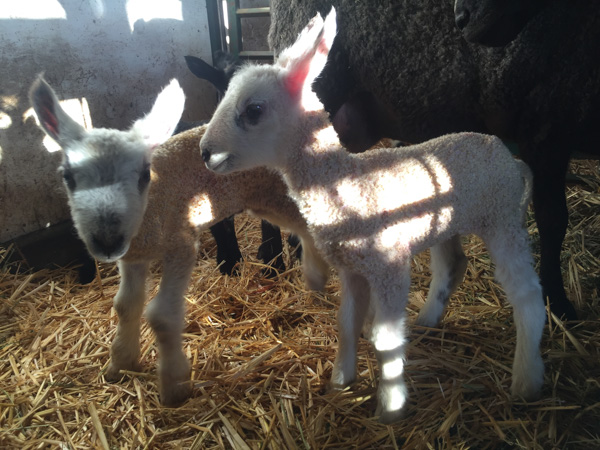 So very cute!!!
So very cute!!!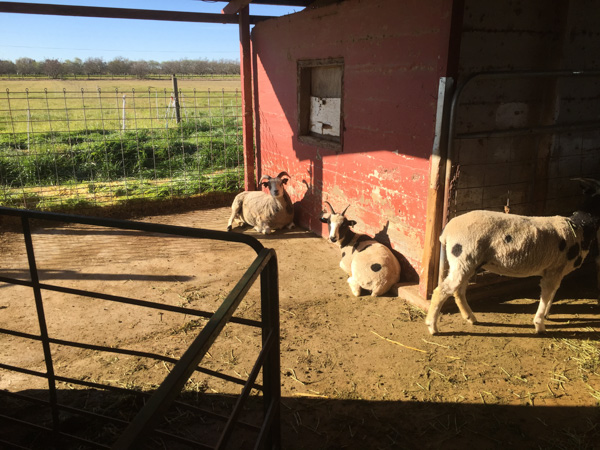 That is Foxy lying down in the back.
That is Foxy lying down in the back.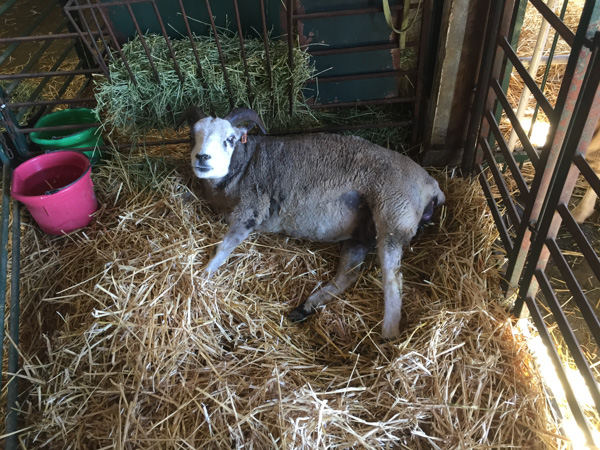 I brought her into the barn about an hour after I first noticed her.
I brought her into the barn about an hour after I first noticed her.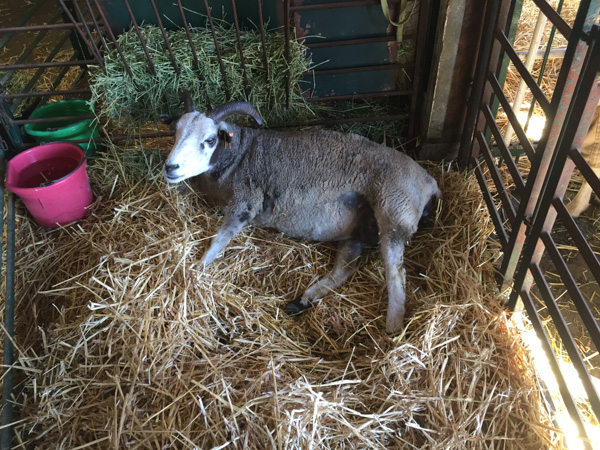
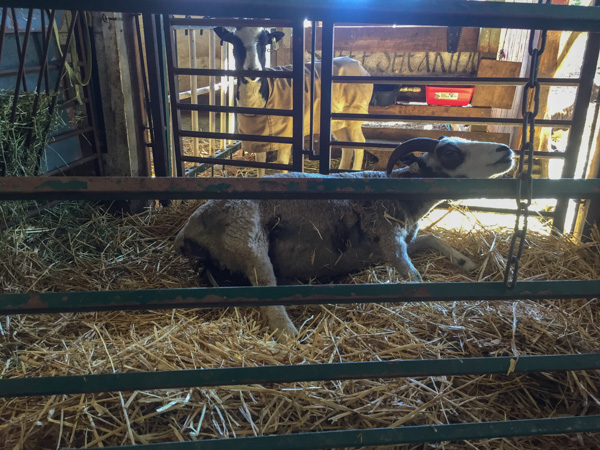
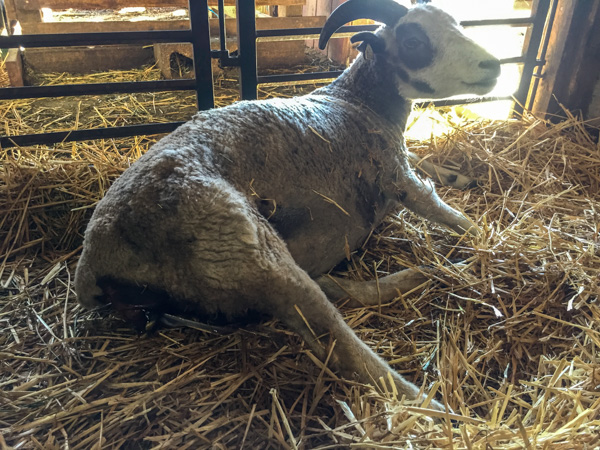
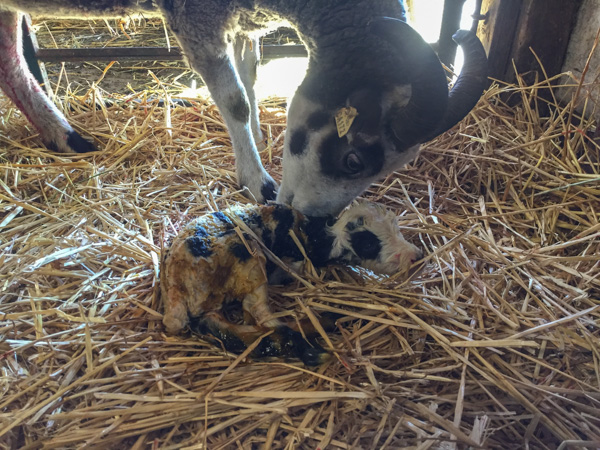 She lambed about an hour later.
She lambed about an hour later.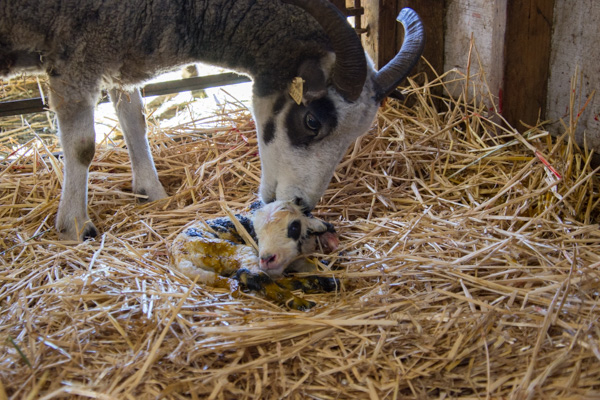
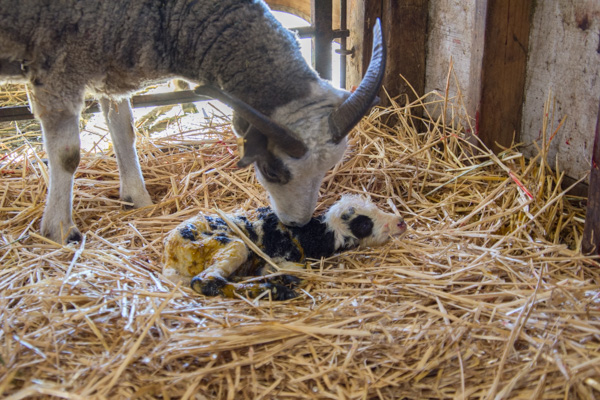
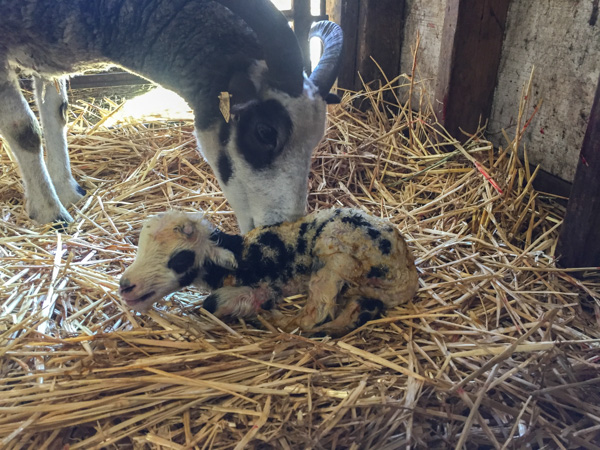
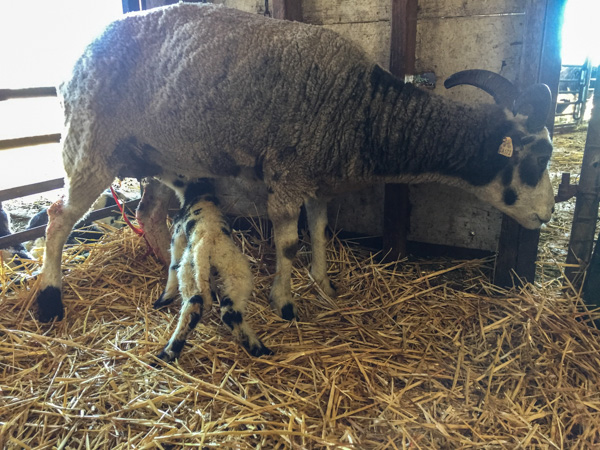
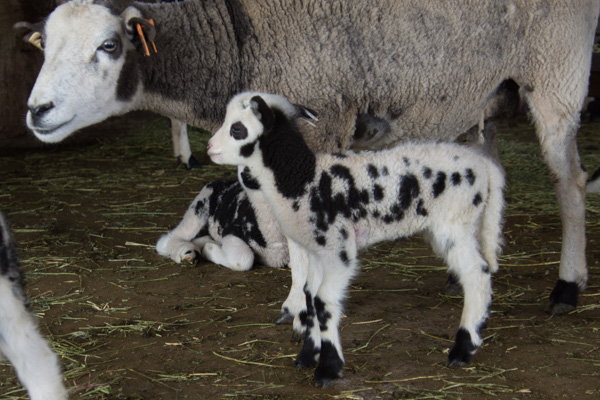 This is Foxy's lamb at 6 days old.
This is Foxy's lamb at 6 days old.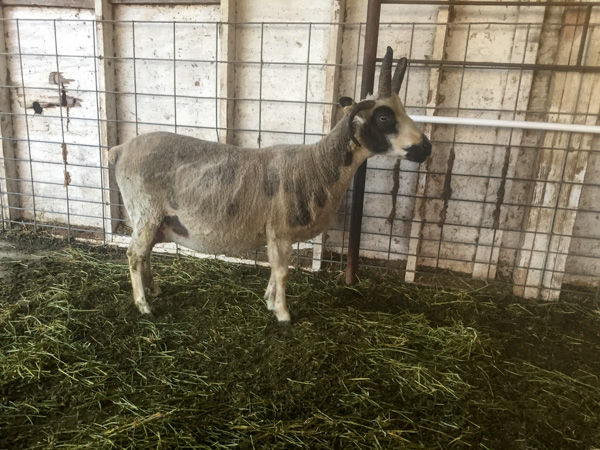 I saw her at about 7 a.m. and knew that she was in labor. The first sign of labor is often just behavior. You have to know what normal behavior looks like to know when something is different. I spend a lot of time looking at my sheep.
I saw her at about 7 a.m. and knew that she was in labor. The first sign of labor is often just behavior. You have to know what normal behavior looks like to know when something is different. I spend a lot of time looking at my sheep.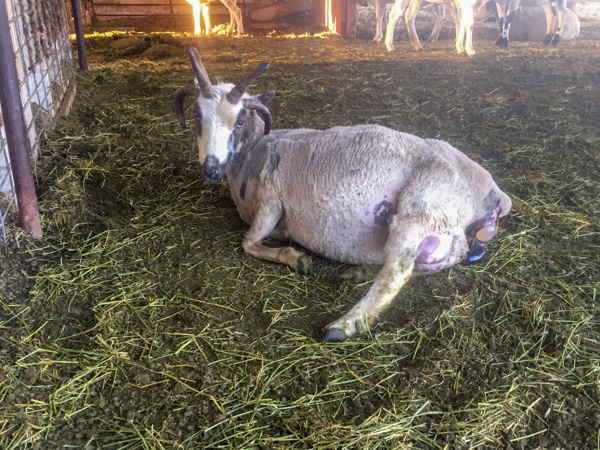 A more obvious sign is seeing the sac emerge when the ewe has contractions.
A more obvious sign is seeing the sac emerge when the ewe has contractions. 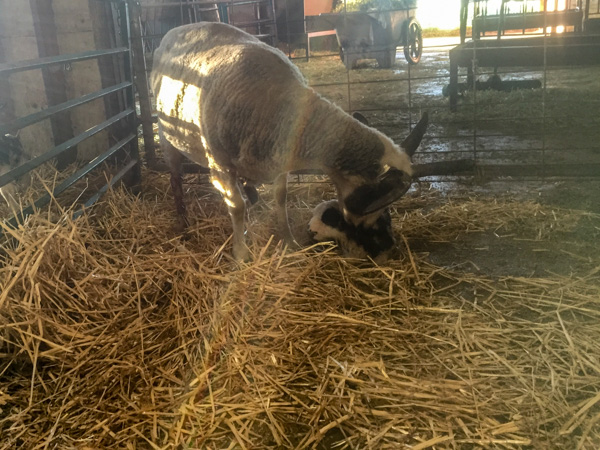 The first lamb was born about 7:20 and I brought the lamb inside the barn.
The first lamb was born about 7:20 and I brought the lamb inside the barn.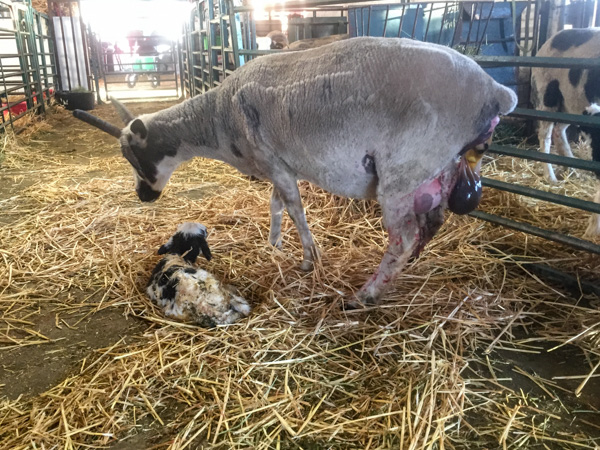 It sometimes takes much longer before the second lamb is born, but this one was coming within five minutes.
It sometimes takes much longer before the second lamb is born, but this one was coming within five minutes.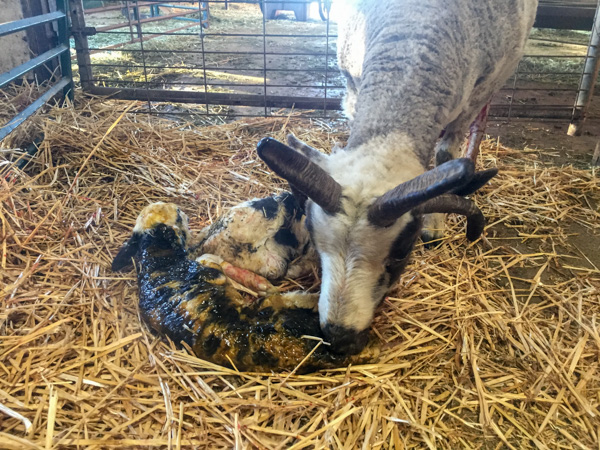
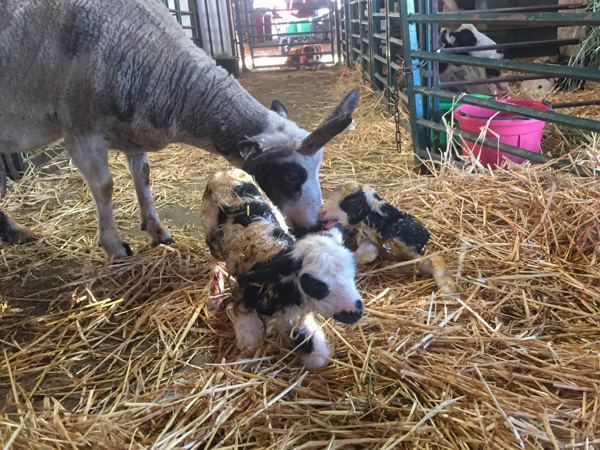 That's the first lamb getting up within ten minutes of birth.
That's the first lamb getting up within ten minutes of birth.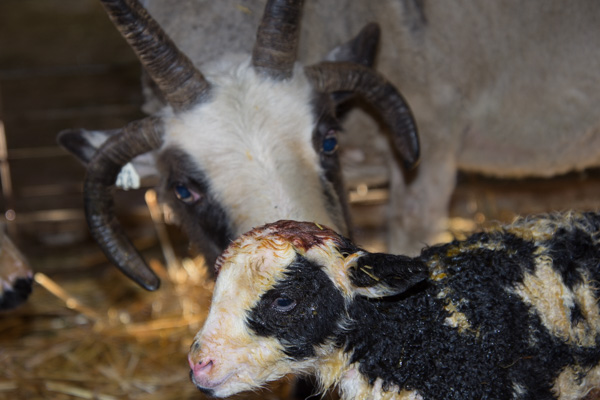
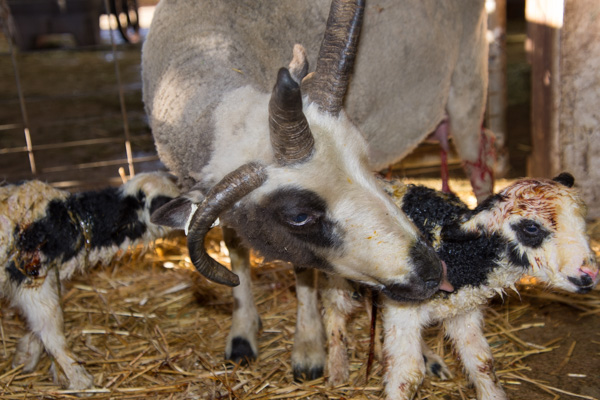
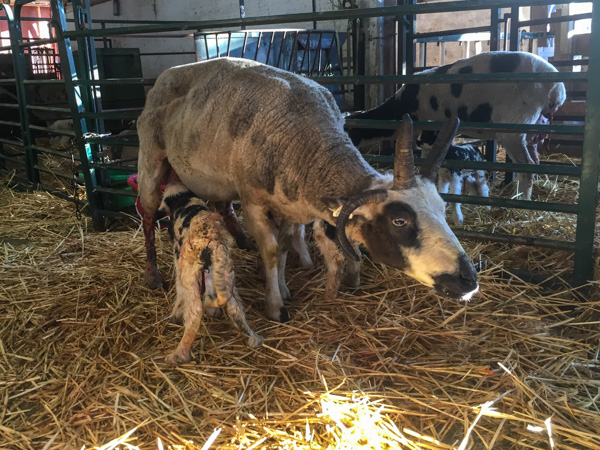 Both lambs were nursing within a half hour.
Both lambs were nursing within a half hour.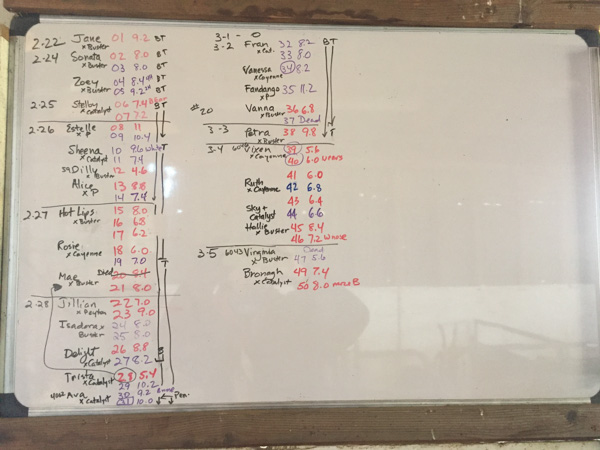 This is the lamb board. These lambs were #49 and 50.
This is the lamb board. These lambs were #49 and 50.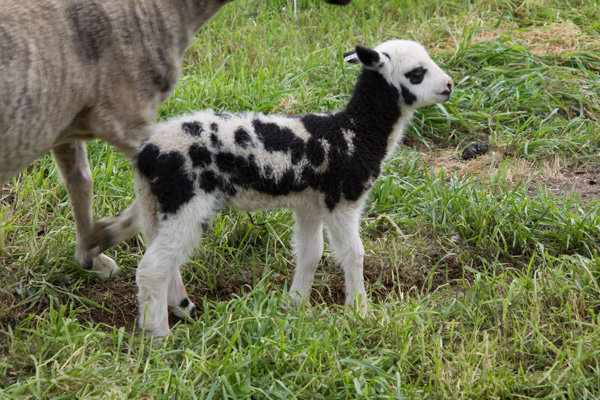 This is one of the lambs one week later.
This is one of the lambs one week later.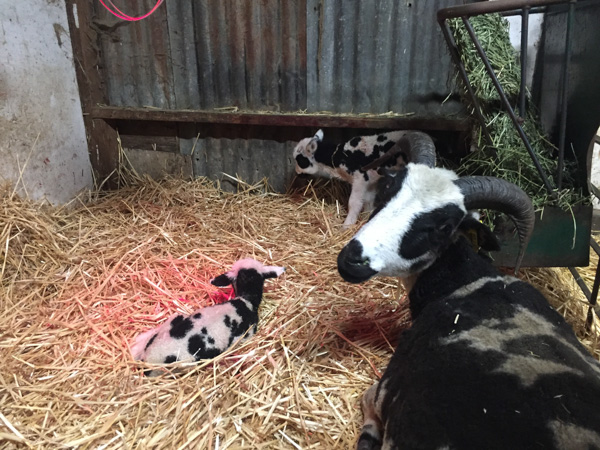 Do you remember this lamb from a couple of posts back? Trista had a 10+ pound lamb and then almost two hours later a 5 pound lamb. She didn't want the little one and I struggled to get it to nurse. I ended up milking Trista and tube feeding the lamb colostrum. I left the lamb with Trista but she became increasingly less happy to have it around and more hostile.
Do you remember this lamb from a couple of posts back? Trista had a 10+ pound lamb and then almost two hours later a 5 pound lamb. She didn't want the little one and I struggled to get it to nurse. I ended up milking Trista and tube feeding the lamb colostrum. I left the lamb with Trista but she became increasingly less happy to have it around and more hostile.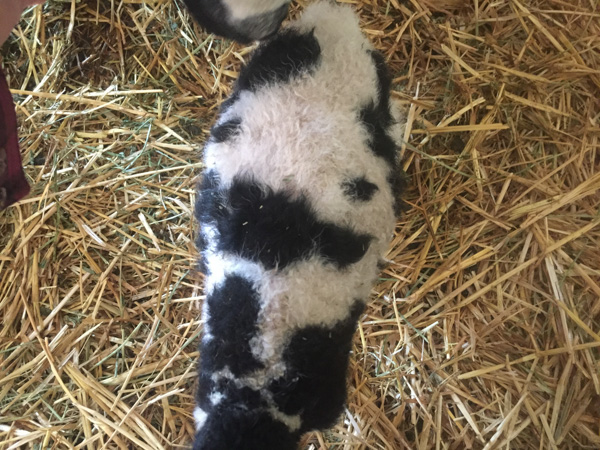 I saw this in the barn. This lamb was standing hunched up like a lamb does when it doesn't feel good. This view from the top down shows how large it's belly is and it was tight as a drum. From previous experience I suspected intestinal atresia, a malformation of the digestive tract where the intestine is not complete. The lamb eats normally at first and then there is no where for the milk to go and this lamb was already over 24 hours old--it didn't have long to live and was in great discomfort.
I saw this in the barn. This lamb was standing hunched up like a lamb does when it doesn't feel good. This view from the top down shows how large it's belly is and it was tight as a drum. From previous experience I suspected intestinal atresia, a malformation of the digestive tract where the intestine is not complete. The lamb eats normally at first and then there is no where for the milk to go and this lamb was already over 24 hours old--it didn't have long to live and was in great discomfort.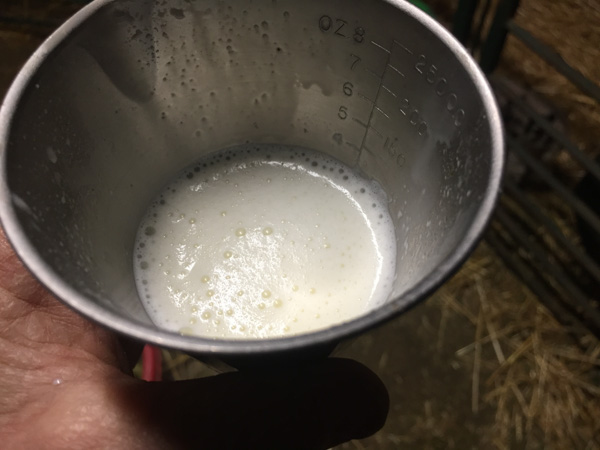 In addition the lamb had stopped nursing so the ewe was at risk of mastitis as her udder filled, even though there was a remaining twin. One side had started to fill more and become uncomfortable. That starts a vicious cycle where the ewe won't let the lamb nurse and that side of the udder gets worse and worse. This is a photo of milk from Trista, the orphan's mom. I got over two cups of milk from the ewe with the baby who died.
In addition the lamb had stopped nursing so the ewe was at risk of mastitis as her udder filled, even though there was a remaining twin. One side had started to fill more and become uncomfortable. That starts a vicious cycle where the ewe won't let the lamb nurse and that side of the udder gets worse and worse. This is a photo of milk from Trista, the orphan's mom. I got over two cups of milk from the ewe with the baby who died.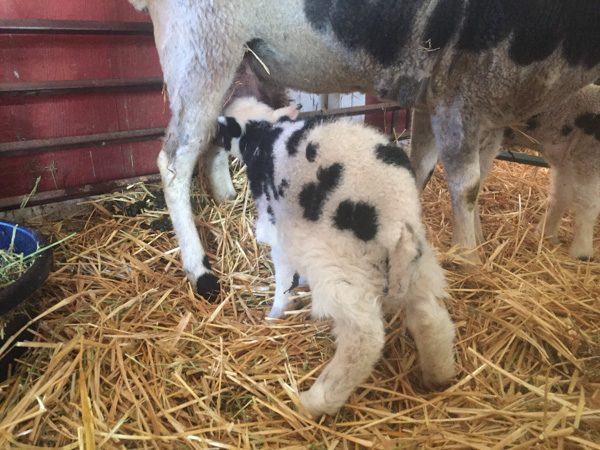 I made a little lamb jacket out of the skin by cutting a neck hole and leg holes. It's kind of hard to tell if you don't know that's what you're looking at.
I made a little lamb jacket out of the skin by cutting a neck hole and leg holes. It's kind of hard to tell if you don't know that's what you're looking at. 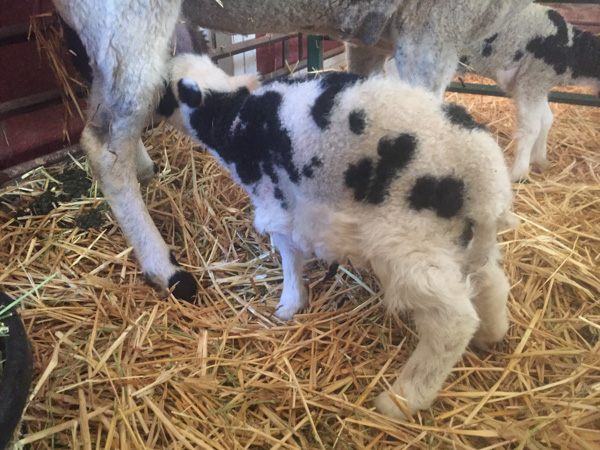 The new lamb was smaller than the one that died so this jacket was a little large. The mom wasn't convinced at first that it was her baby, but she didn't outright reject it. The lamb had eaten (been tube fed) just two hours before so it wasn't hungry. But later that night it was hungry. It was on it's feet and when I held the ewe still it nursed!
The new lamb was smaller than the one that died so this jacket was a little large. The mom wasn't convinced at first that it was her baby, but she didn't outright reject it. The lamb had eaten (been tube fed) just two hours before so it wasn't hungry. But later that night it was hungry. It was on it's feet and when I held the ewe still it nursed! 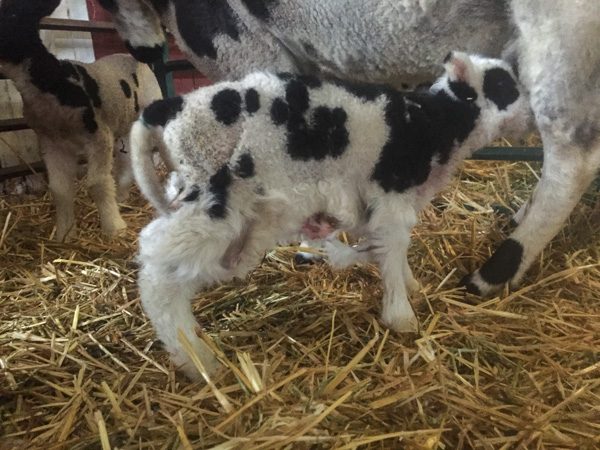 The next day the jacket was beginning to smell. The idea is that at first the mom smells her baby and eventually gets used to the new lamb smell. So our transition was original lamb smell mingled with new lamb smell, new lamb smell mingled with dead smell, all new lamb smell. I had cut a portion of the skin off to get more of the new lamb smell and because I wanted the lamb to be able to adjust to the cold when the second skin came off. But this skin jacket was so big that at that point it got tangled up and I took it off.
The next day the jacket was beginning to smell. The idea is that at first the mom smells her baby and eventually gets used to the new lamb smell. So our transition was original lamb smell mingled with new lamb smell, new lamb smell mingled with dead smell, all new lamb smell. I had cut a portion of the skin off to get more of the new lamb smell and because I wanted the lamb to be able to adjust to the cold when the second skin came off. But this skin jacket was so big that at that point it got tangled up and I took it off.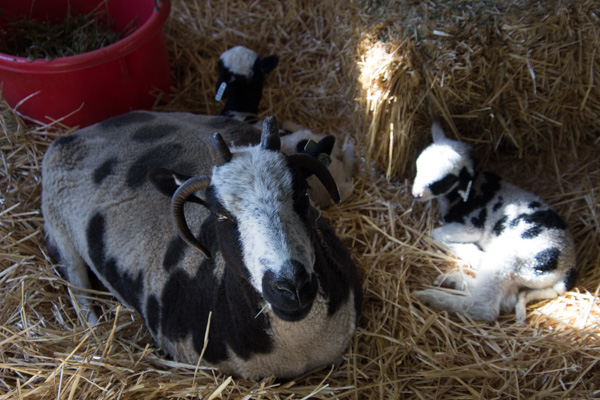 We have success. I haven't had to hold the ewe for a few days while they have been in a group pen. They will go out tomorrow and I'll keep an eye on them. But I think the baby has a new mama.
We have success. I haven't had to hold the ewe for a few days while they have been in a group pen. They will go out tomorrow and I'll keep an eye on them. But I think the baby has a new mama.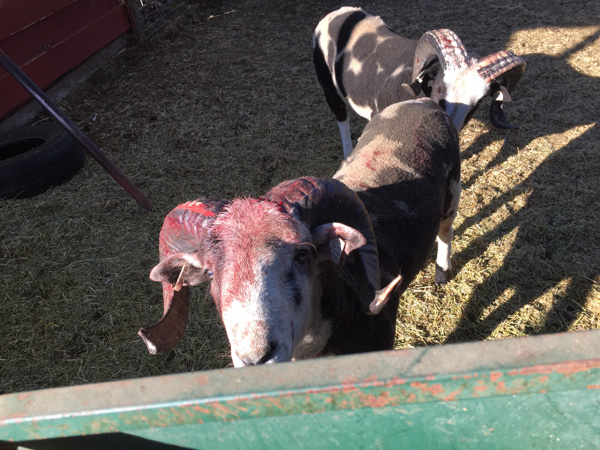 This is Cayenne...
This is Cayenne...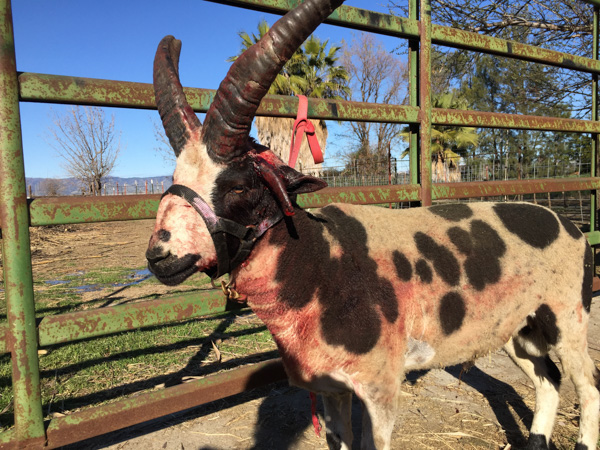 ...and this is Serrano. Yearling rams trying to figure out who is boss. I think most of the blood came from a fifth horn that was behind Serrano's lower horn--that horn is gone now. I'm not sure who won. Neither of them seemed to be feeling very good for a day or two.
...and this is Serrano. Yearling rams trying to figure out who is boss. I think most of the blood came from a fifth horn that was behind Serrano's lower horn--that horn is gone now. I'm not sure who won. Neither of them seemed to be feeling very good for a day or two.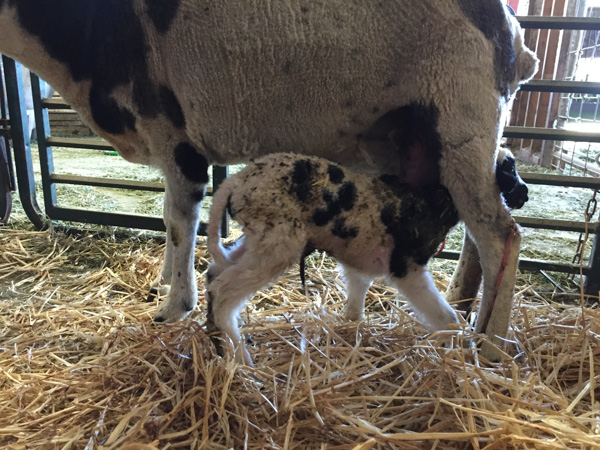
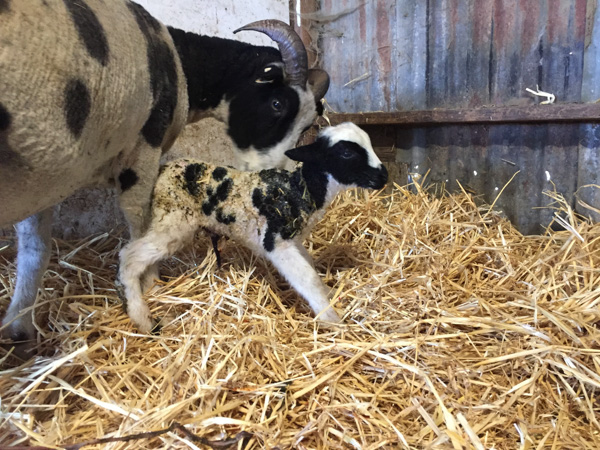
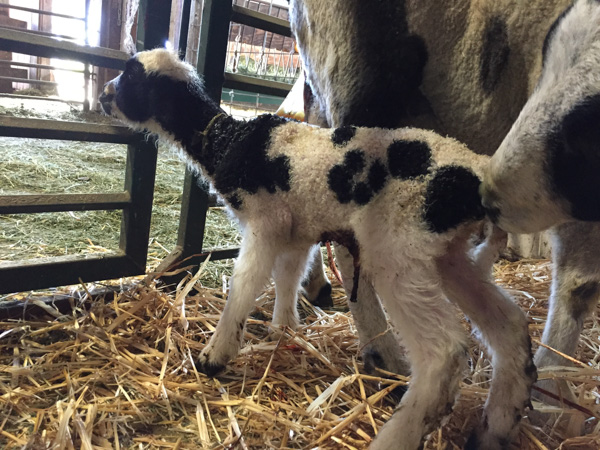
 The
The 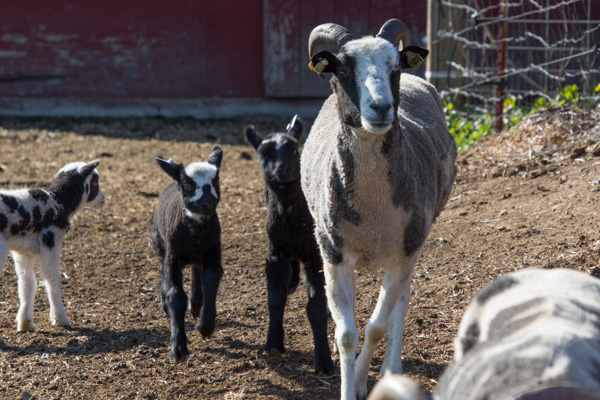 Estelle and lambs.
Estelle and lambs.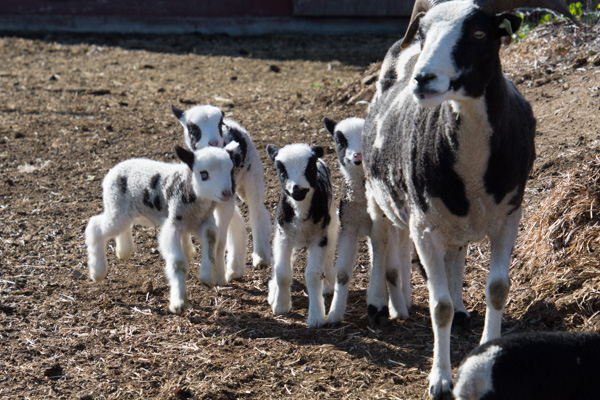 Ht Lips and her triplets plus an extra.
Ht Lips and her triplets plus an extra.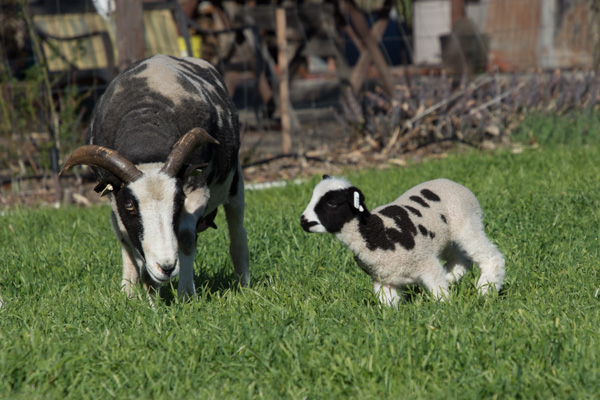
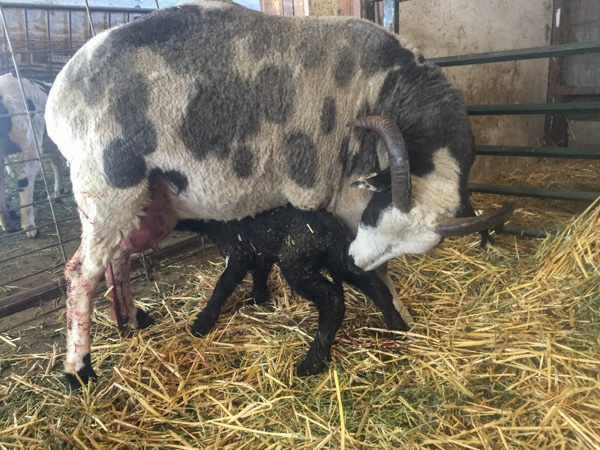 Back in the barn lambing has continued at quite a clip. This is Fandango and her BFL-cross lamb.
Back in the barn lambing has continued at quite a clip. This is Fandango and her BFL-cross lamb.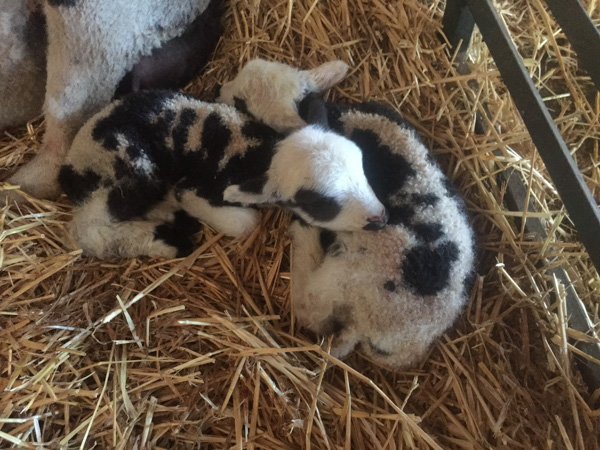 Vixen's twins.
Vixen's twins.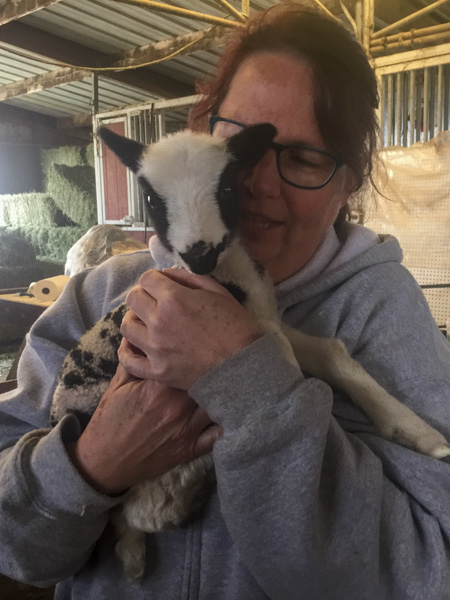 There are plenty of lambs to cuddle.
There are plenty of lambs to cuddle.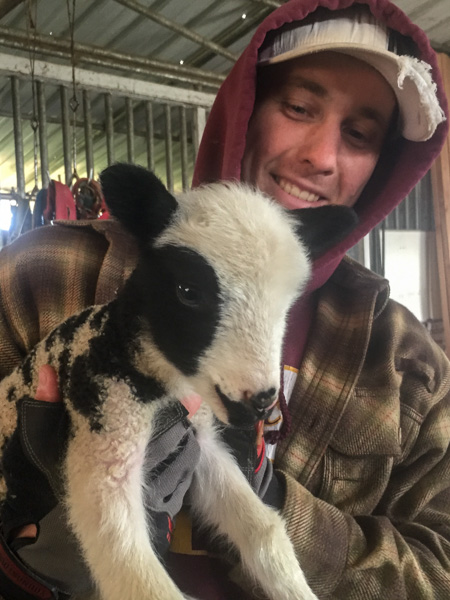
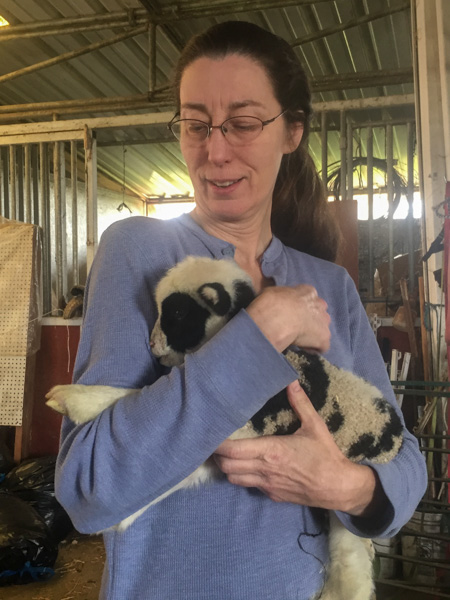
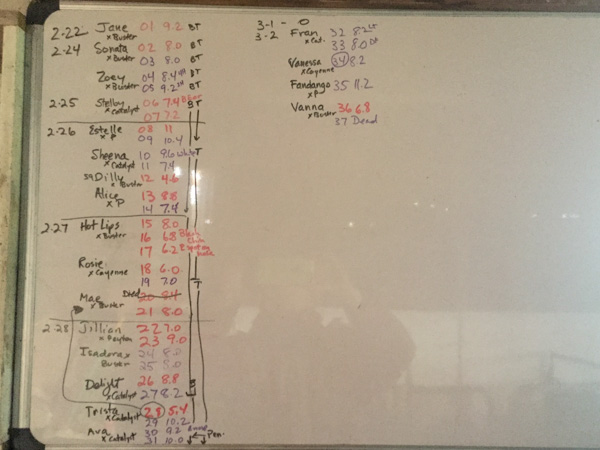 Here is the lambing count a week ago.
Here is the lambing count a week ago. 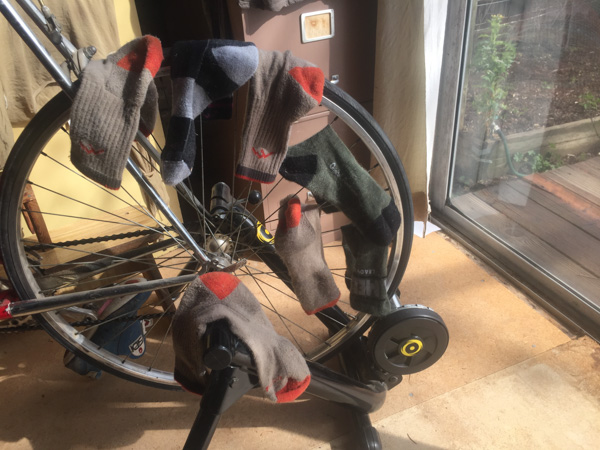 My bike set up on a trainer in the house. The only use it is getting right now is as a sock drying rack right.
My bike set up on a trainer in the house. The only use it is getting right now is as a sock drying rack right.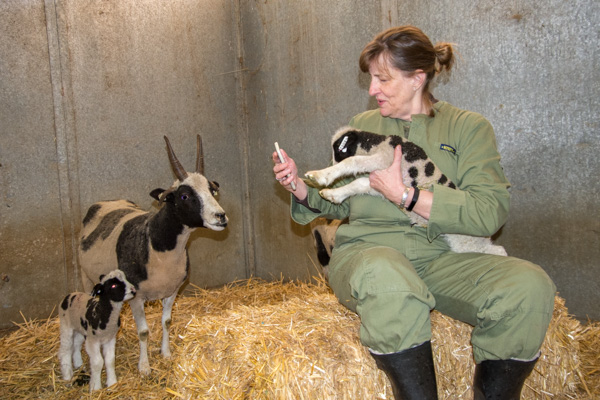
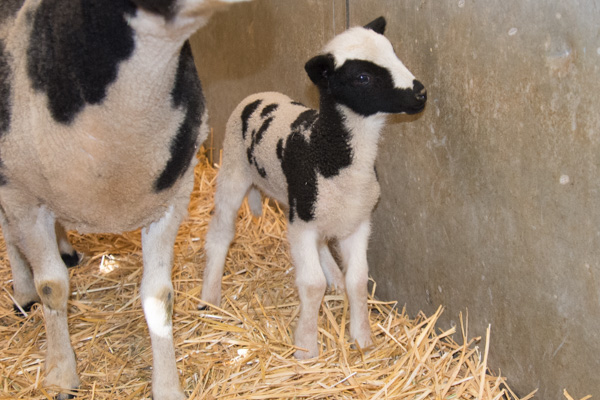 This is the first lamb born way back on February 22.
This is the first lamb born way back on February 22.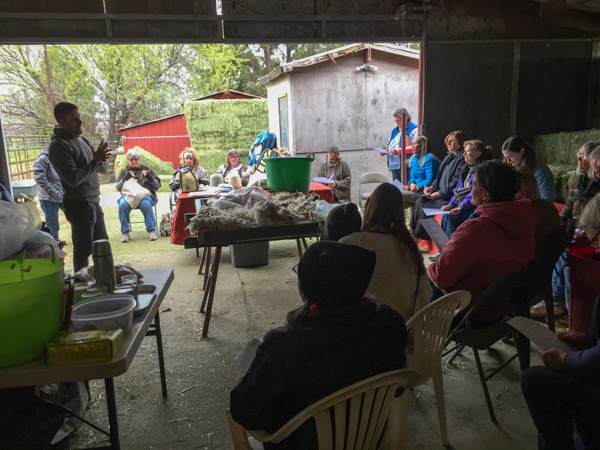 Wednesday was quite a day with five sets of twins born. There was a Fibershed Ag Coop Board meeting at noon, but the representative photo for that would just be Stephany and me on the phone for two hours. But the main event was not lambing or the meeting. Ben Hostetler of Mountain Meadow Wool came to speak to a gathering of Fibershed producers and other interested people and talk about value-added processing and how to figure out cost effectiveness, etc.
Wednesday was quite a day with five sets of twins born. There was a Fibershed Ag Coop Board meeting at noon, but the representative photo for that would just be Stephany and me on the phone for two hours. But the main event was not lambing or the meeting. Ben Hostetler of Mountain Meadow Wool came to speak to a gathering of Fibershed producers and other interested people and talk about value-added processing and how to figure out cost effectiveness, etc.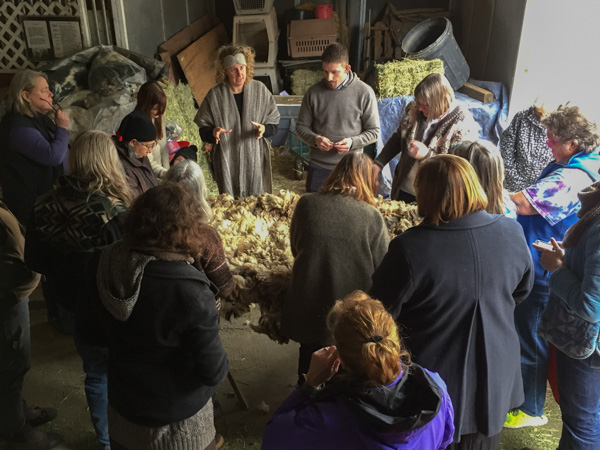 We also looked at fleeces and discussed skirting and cleanliness of fleeces to be sent to the mill. Oh, and do you see that stack of alfalfa in the background of the first photo of Ben and the group? I had made a call to say DO NOT bring hay on Wednesday because there would be a lot of people and a storm is coming. The hay showed up on Wednesday and Dan got about half of it in the barn before people arrived for Ben's talk.
We also looked at fleeces and discussed skirting and cleanliness of fleeces to be sent to the mill. Oh, and do you see that stack of alfalfa in the background of the first photo of Ben and the group? I had made a call to say DO NOT bring hay on Wednesday because there would be a lot of people and a storm is coming. The hay showed up on Wednesday and Dan got about half of it in the barn before people arrived for Ben's talk. 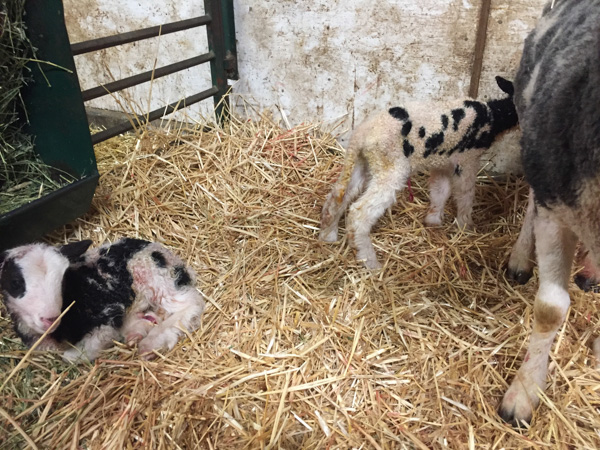 I ended up pulling twins and all was OK although in hindsight I'm sure that this ewe did not need intervention, just more time. In the meantime while I was dealing with that ewe Trista popped out another lamb. This was almost two hours after the first and it was such a tiny thing that I'm not sure she even noticed. She did not want that lamb--that's the small one in the photo under the heat lamp. By this time it was almost 6:00 and the rain was starting. A few of the people at the talk had stayed around to help. Dan and Ben brought the rest of the hay in under cover. I dealt with the cold, rejected lamb. I ended up tube feeding it colostrum because we could not get it up to suck even when we held Trista still. Ben and Dan helped with chores while Stephany went in to clean up the kitchen and order pizza and pasta to be delivered. That was really the best way to end the day because by then I didn't want to go out anyway. More about that lamb in a later post.
I ended up pulling twins and all was OK although in hindsight I'm sure that this ewe did not need intervention, just more time. In the meantime while I was dealing with that ewe Trista popped out another lamb. This was almost two hours after the first and it was such a tiny thing that I'm not sure she even noticed. She did not want that lamb--that's the small one in the photo under the heat lamp. By this time it was almost 6:00 and the rain was starting. A few of the people at the talk had stayed around to help. Dan and Ben brought the rest of the hay in under cover. I dealt with the cold, rejected lamb. I ended up tube feeding it colostrum because we could not get it up to suck even when we held Trista still. Ben and Dan helped with chores while Stephany went in to clean up the kitchen and order pizza and pasta to be delivered. That was really the best way to end the day because by then I didn't want to go out anyway. More about that lamb in a later post.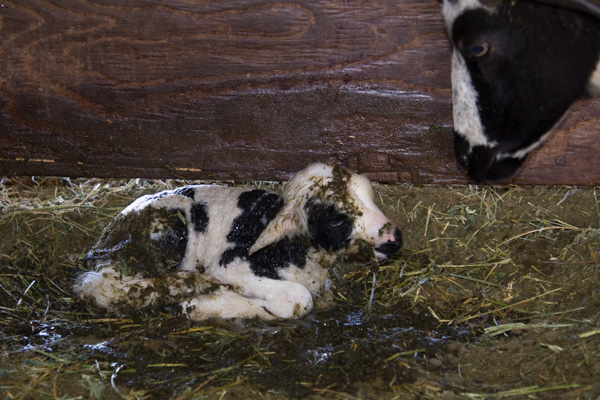 Skipping ahead to the next day. Petra was the only ewe to lamb on Thursday.
Skipping ahead to the next day. Petra was the only ewe to lamb on Thursday.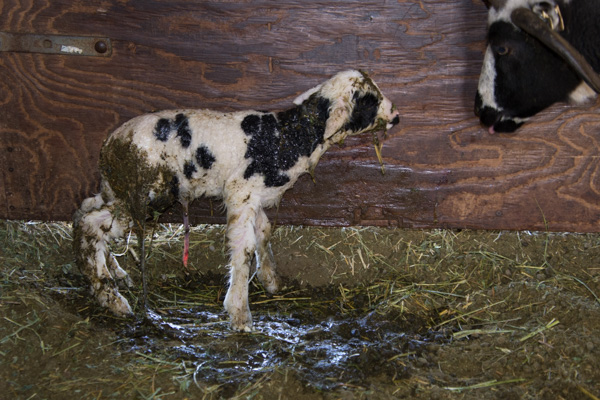
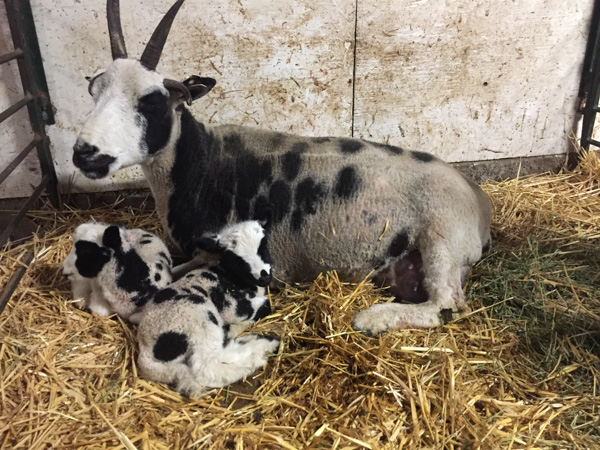 Isadora is one of the ewes who had lambed on Wednesday. By the next day I was worried about mastitis. She has a lumpy uneven udder from previous mastitis and it seemed to get hard again. I spent some time massaging and using warm compresses (easy with hot water in a disposable diaper). She didn't developed mastitis so I think it was just the normal engorgement coupled with the hard, scarred areas from before that I was feeling.
Isadora is one of the ewes who had lambed on Wednesday. By the next day I was worried about mastitis. She has a lumpy uneven udder from previous mastitis and it seemed to get hard again. I spent some time massaging and using warm compresses (easy with hot water in a disposable diaper). She didn't developed mastitis so I think it was just the normal engorgement coupled with the hard, scarred areas from before that I was feeling.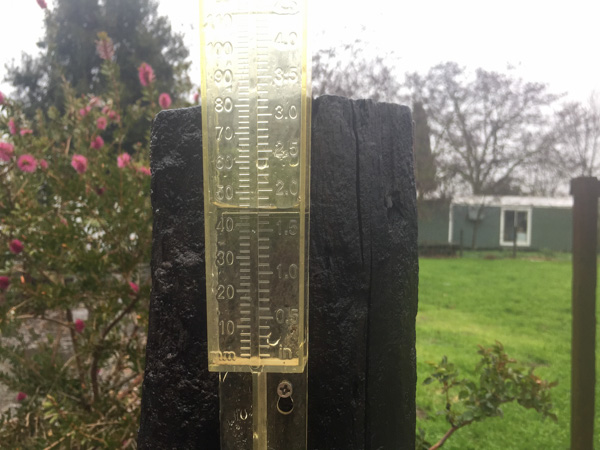 Wednesday night through Thursday we had 1.8" of rain after almost no rain in all of February.
Wednesday night through Thursday we had 1.8" of rain after almost no rain in all of February.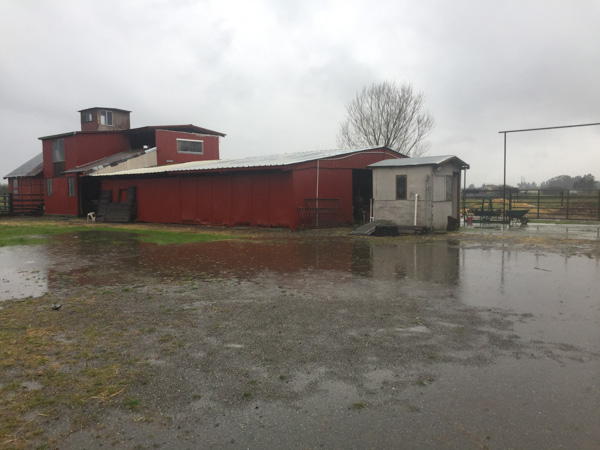 That's all it takes for our place to look like this.
That's all it takes for our place to look like this. 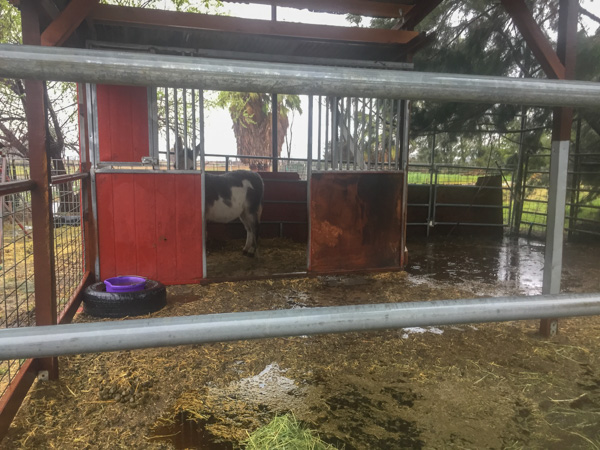
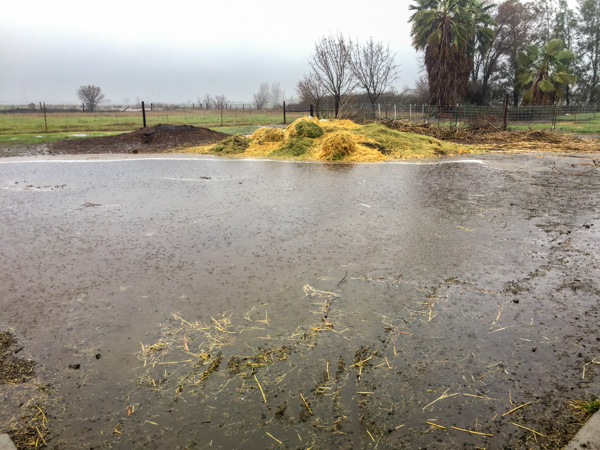
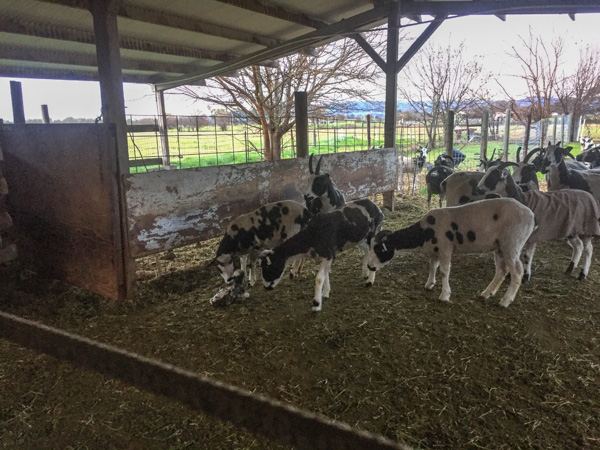 So I looked over the barn wall where I spy on the ewes and saw this. Yearlings aren't always sure about what to do with a lamb and need a little time to let their instinct kick in. It is important that a young ewe has a chance to figure out that the lamb is hers and that she really does want it. You don't want to interrupt that bonding time. However she can also be bullied or distracted by other ewes who are curious or close to lambing and will start to mother the lamb themselves.
So I looked over the barn wall where I spy on the ewes and saw this. Yearlings aren't always sure about what to do with a lamb and need a little time to let their instinct kick in. It is important that a young ewe has a chance to figure out that the lamb is hers and that she really does want it. You don't want to interrupt that bonding time. However she can also be bullied or distracted by other ewes who are curious or close to lambing and will start to mother the lamb themselves.
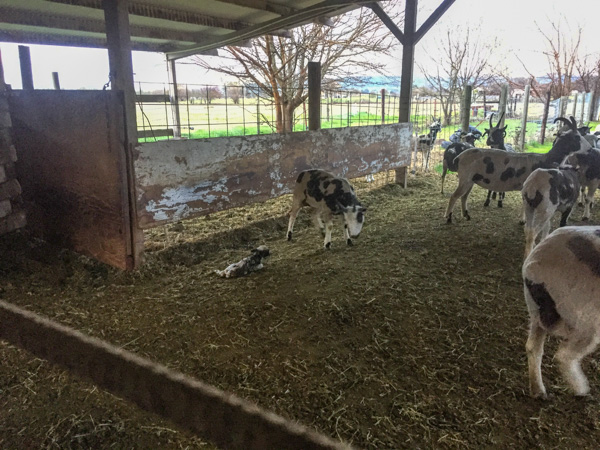 I walked around the gate briefly to push the other ewes away and then backed off so that Dilly would approach her lamb again.
I walked around the gate briefly to push the other ewes away and then backed off so that Dilly would approach her lamb again.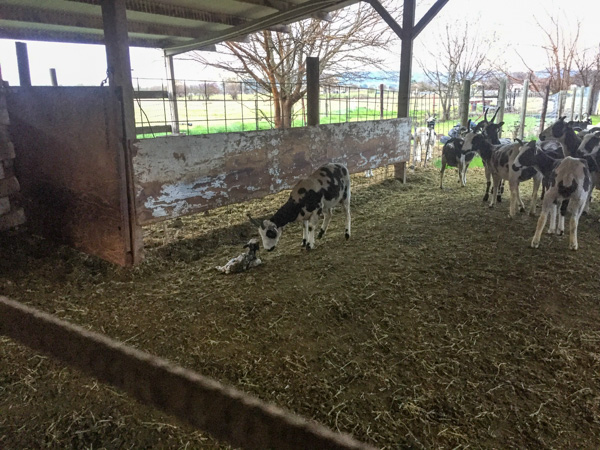 I gave her some time and then slowly picked up the lamb and got her to follow it into the barn.
I gave her some time and then slowly picked up the lamb and got her to follow it into the barn.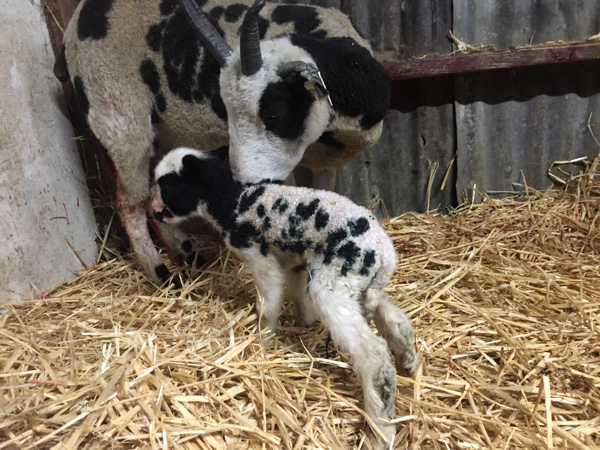 This lamb was only 4.6 pounds. The other Jacob lambs are more often 7 to 8 pounds or even more.
This lamb was only 4.6 pounds. The other Jacob lambs are more often 7 to 8 pounds or even more. 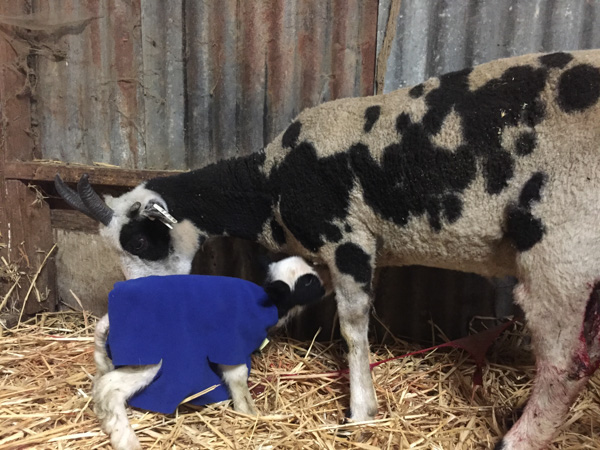 It was stormy and cold so I put this little lamb coat on it for the night. However the coat was too big and got wet. By morning I took it off.
It was stormy and cold so I put this little lamb coat on it for the night. However the coat was too big and got wet. By morning I took it off.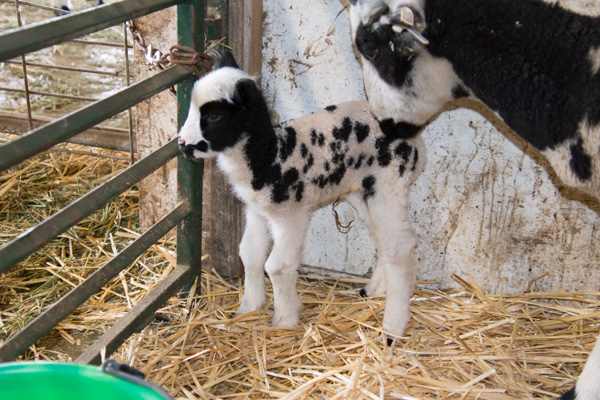 Dilly's lamb at 2 days old.
Dilly's lamb at 2 days old. 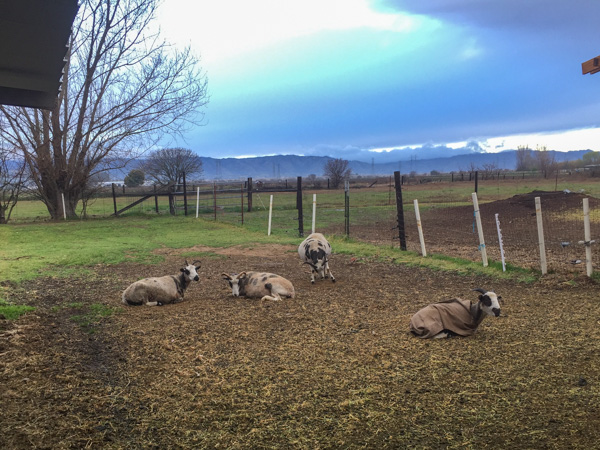 That is her pawing and looking restless during morning chores.
That is her pawing and looking restless during morning chores.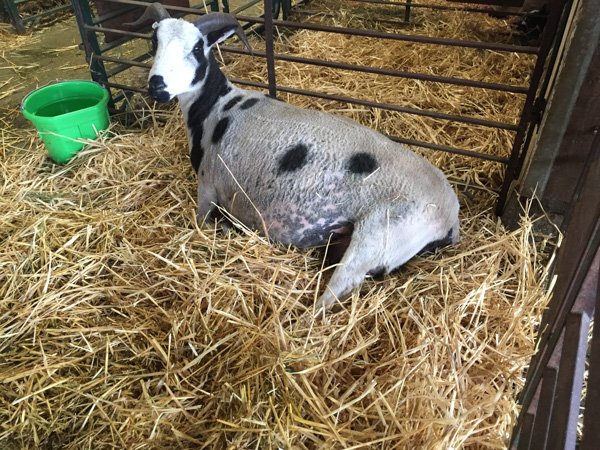 When she looked more as though she were in active labor I brought her into the barn. That was about 10:15.
When she looked more as though she were in active labor I brought her into the barn. That was about 10:15.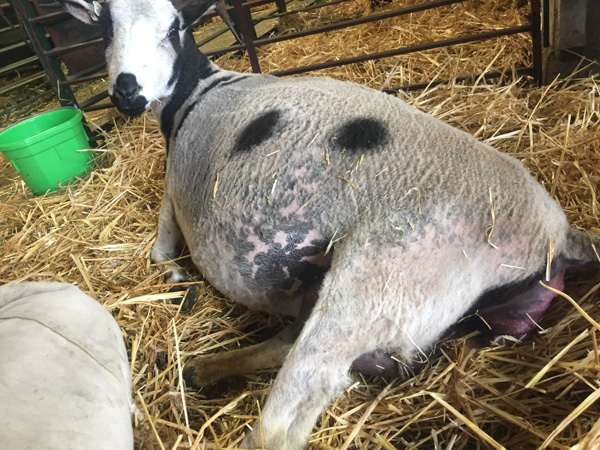 At about noon the sac was visible.
At about noon the sac was visible.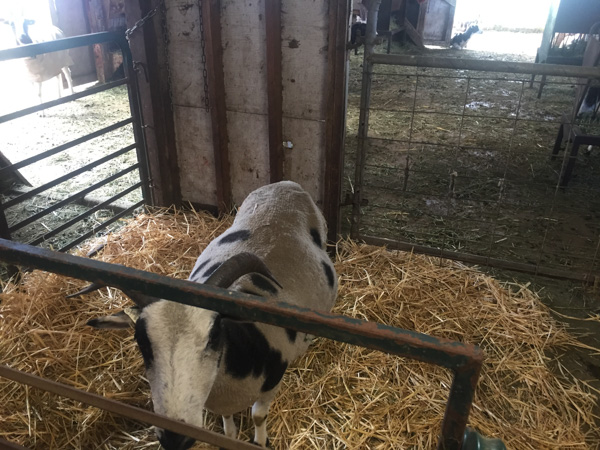 This view, taken about 2:00 shows how, as labor progresses, the sides are sunken in front of the hips. I had been waiting for Sheena to have her lambs before I went to town, but I finally decided to make a quick trip. When I came back at 3:00 she was lying down and pushing but I saw only the nose, which at that point looked somewhat swollen. When I felt for the lamb position, the feet were at about a 2:00 position instead of below the head and out in front. I pushed the lamb back so that I could make sure that the feet matched up to the right lamb, brought them around to the 6:00 position and then pulled the lamb easily.
This view, taken about 2:00 shows how, as labor progresses, the sides are sunken in front of the hips. I had been waiting for Sheena to have her lambs before I went to town, but I finally decided to make a quick trip. When I came back at 3:00 she was lying down and pushing but I saw only the nose, which at that point looked somewhat swollen. When I felt for the lamb position, the feet were at about a 2:00 position instead of below the head and out in front. I pushed the lamb back so that I could make sure that the feet matched up to the right lamb, brought them around to the 6:00 position and then pulled the lamb easily.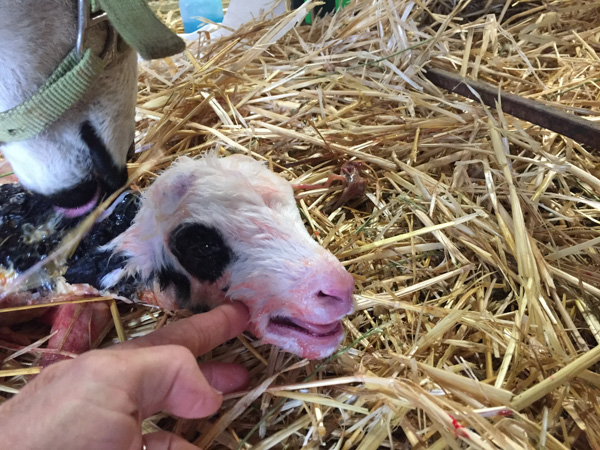 As soon as the lamb was out Sheena went to work.
As soon as the lamb was out Sheena went to work.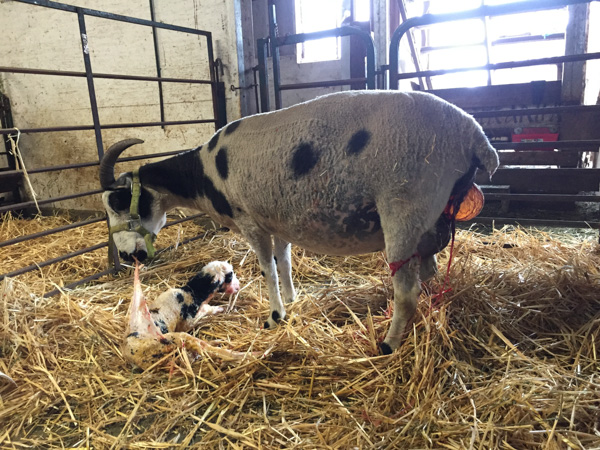 The sac for the next lamb showed within a few minutes.
The sac for the next lamb showed within a few minutes. 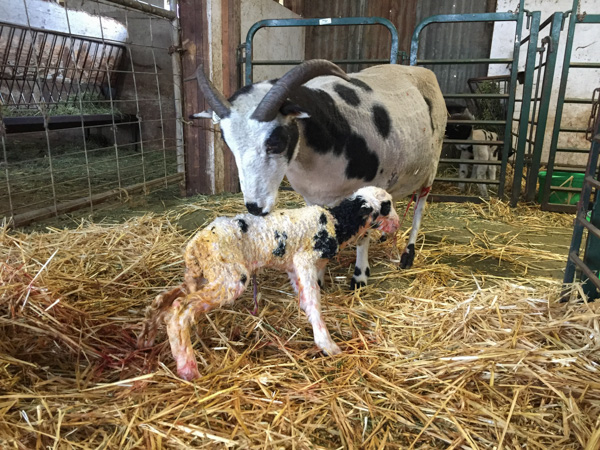 Lamb #1 was on his feet within 8 minutes.
Lamb #1 was on his feet within 8 minutes.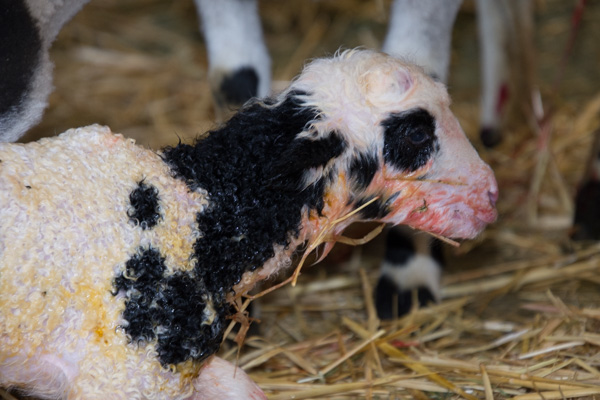 You can see this ram lamb's horn buds.
You can see this ram lamb's horn buds.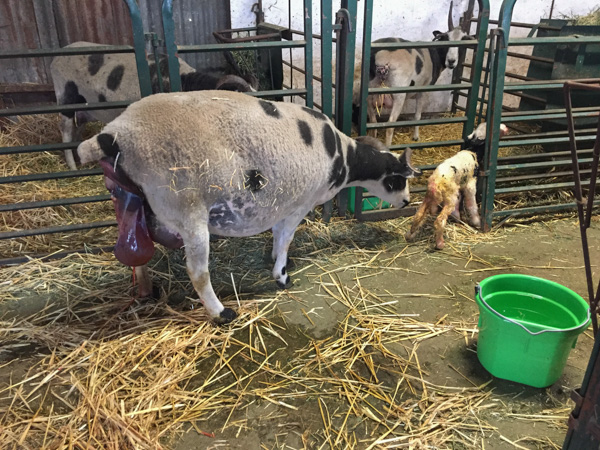 Sheena barely noticed as she pushed out the second lamb about 15 minutes later.
Sheena barely noticed as she pushed out the second lamb about 15 minutes later.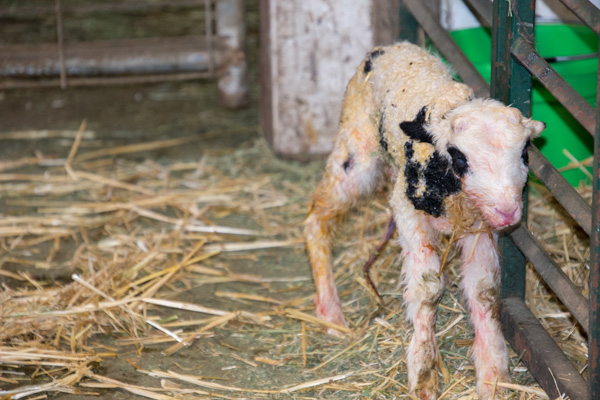 Lamb #1 is mostly white.
Lamb #1 is mostly white.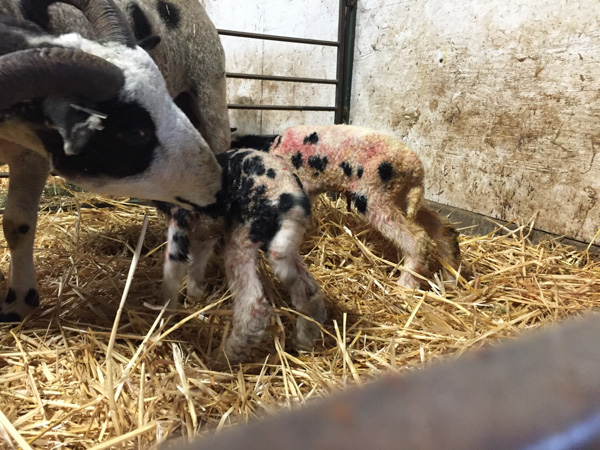 Lamb #2 has a lot of color and has lilac markings. Catalyst is the sire.
Lamb #2 has a lot of color and has lilac markings. Catalyst is the sire.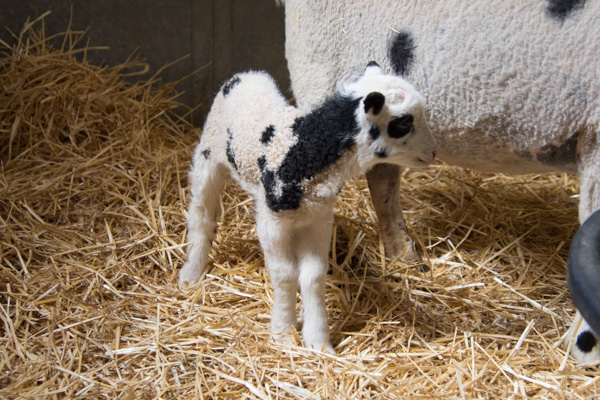 This is the first lamb two days later.
This is the first lamb two days later.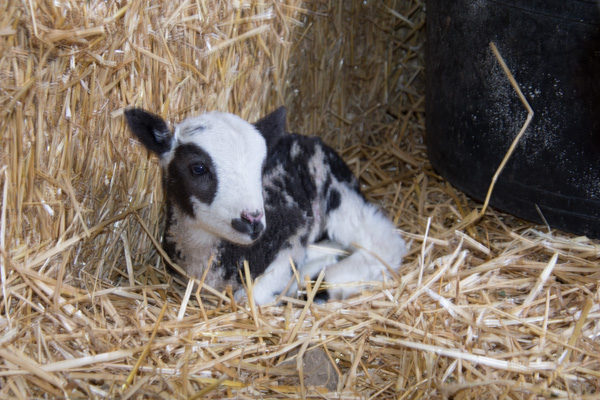 Here is the second lamb.
Here is the second lamb.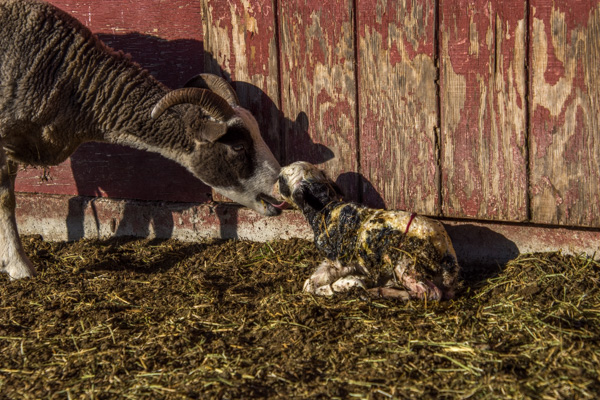 Lamb #1. These aren't usually a pretty side when just born. Slime, dirt, blood.
Lamb #1. These aren't usually a pretty side when just born. Slime, dirt, blood. 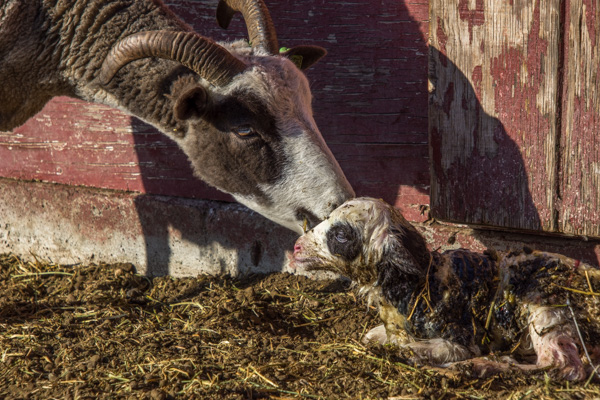 Jacob ewes are usually very good mothers and the lambs are vigorous. Shelby was cleaning up her baby...
Jacob ewes are usually very good mothers and the lambs are vigorous. Shelby was cleaning up her baby...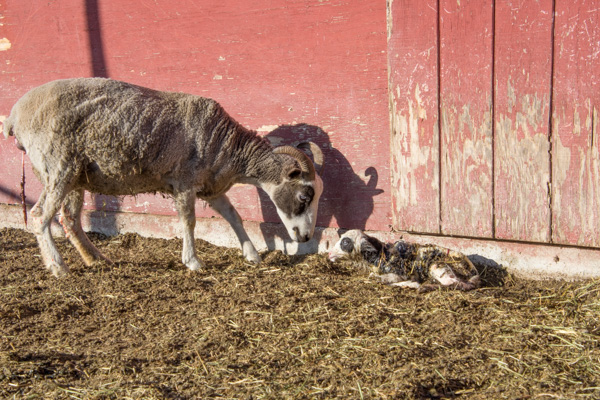 ...even while pawing the ground and having contractions for the second.
...even while pawing the ground and having contractions for the second.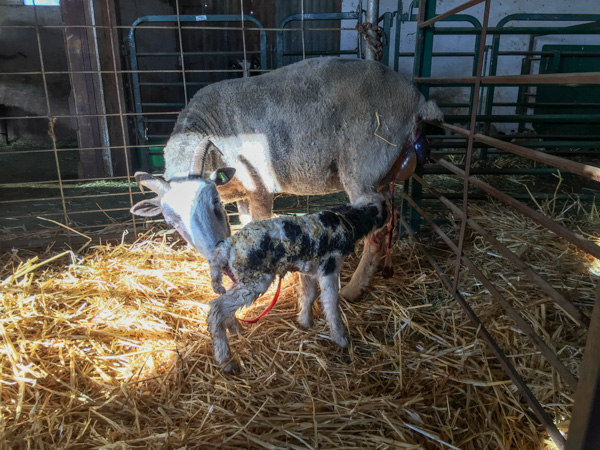 I got them inside the barn and the lamb got to its feet and started looking for milk.
I got them inside the barn and the lamb got to its feet and started looking for milk.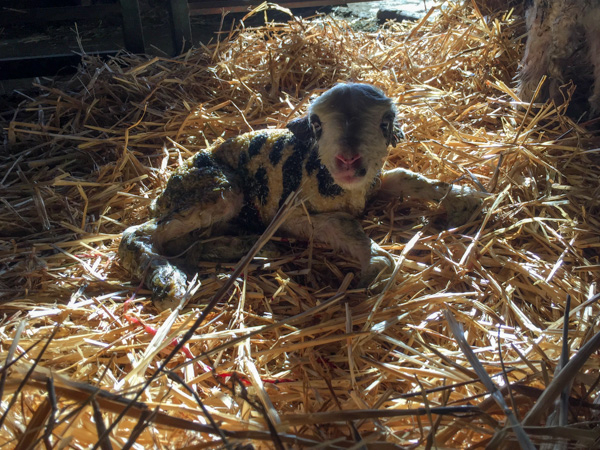 Lamb #2.
Lamb #2.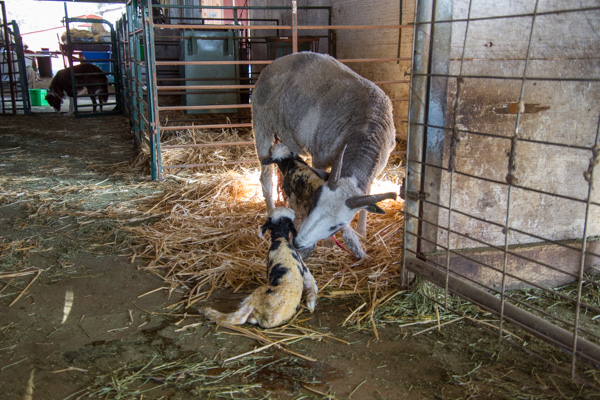 The first lamb is nursing while Shelby cleans the second.
The first lamb is nursing while Shelby cleans the second.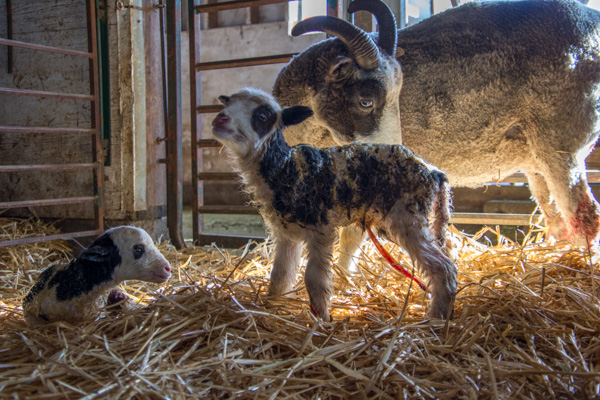 I love the look of this one. These are both lilac ewe lambs sired by Catalyst.
I love the look of this one. These are both lilac ewe lambs sired by Catalyst.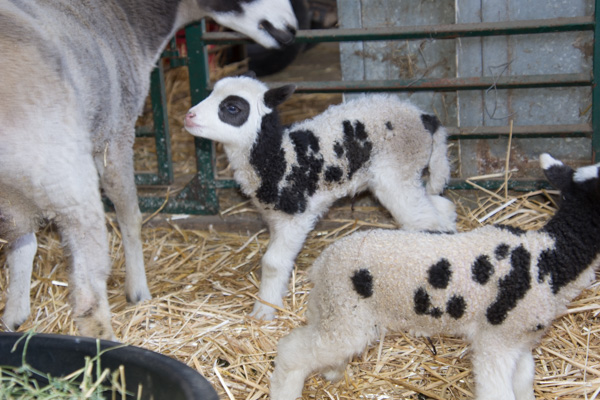 Here they are three days later.
Here they are three days later.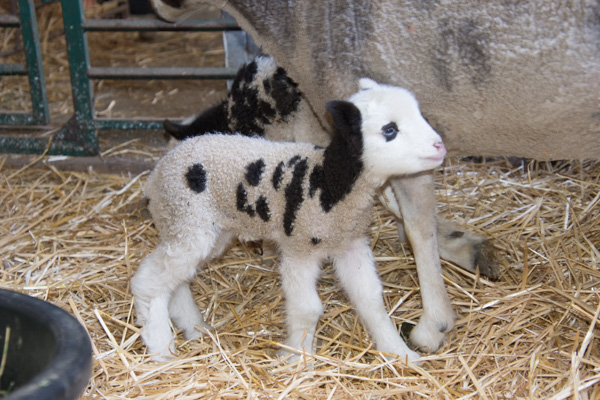 These lambs are listed on my
These lambs are listed on my 